How to Write an Example Essay
Jered slusher.

The example essay is one of the most basic essays in academic writing, but can be extremely difficult if you've never written one or do not know what to write about. Example essays focus on one main idea which you prove with several specific, convincing examples. If you're stuck on how to write an example essay, you can follow a few simple steps to dig yourself out of the rut and write an example essay that you can be proud of.

Explore this article
- Review your example essay assignment sheet
- Brainstorm example essay topics
- Write a thesis statement for each topic
- Write down three to five examples to prove your thesis statement for each topic
- Choose the topic
- Sit down and write your example essay
- Edit your example essay
- Revise your example essay
1 Review your example essay assignment sheet
Review your example essay assignment sheet. List the criteria of the essay on a separate sheet of paper. Make note of anything that confuses you and ask your professor for clarification.
2 Brainstorm example essay topics
Brainstorm example essay topics. List three to five topics that you are interested in or would like to write about. Brainstorm ideas for what you’re going to write if the assignment is specifically about one topic. Make a sub-list for each topic that you could write about.
3 Write a thesis statement for each topic
Write a thesis statement for each topic. A thesis statement is a single sentence that you will argue in your paper. For example, if you were to write on the topic of dog training, you could have a thesis statement such as “Dogs listen better to trainers who use positive rewards instead of scolding and hitting.”
4 Write down three to five examples to prove your thesis statement for each topic
Write down three to five examples to prove your thesis statement for each topic. Use the “SEE” model as a formula for each example. “S” stands for “statement” and is a reiteration of what you’re trying to prove. For example, your statement could be that a dog trainer who rewards a dog for relieving itself outside sees faster and more permanent results than a trainer who scolds a dog for doing it inside. The first “E” stands for “example” and is the proof that you need to back up what you say in your statement. Provide specific examples to prove your statement. The last “E” stands for “Explanation” and is used to reiterate how your example ties into the thesis. For example, you might explain that because the first trainer used positive rewards, he saw better results than the trainer who scolded the dog. Therefore, trainers should use positive rewards when potty training a dog.
5 Choose the topic
Choose the topic you most want to write about. Pick the topic that is most interesting and that has enough clear and convincing examples to prove your point.
6 Sit down and write your example essay
Sit down and write your example essay. Write an introductory paragraph that gives background information into your topic and draws the reader into the essay. Write your body paragraphs using the “SEE” model examples you came up with. Write your conclusion by tying in all of the examples and restating how the examples relate to your thesis.
7 Edit your example essay
Edit your example essay. Read back through your essay and make sure that all of your examples prove your point adequately. Have a friend read your essay and ask her what she thinks could be explained more clearly.
8 Revise your example essay
Revise your example essay. Print a copy of the essay, and use a pen to go through and correct any grammar or mechanical errors that you find.
- 1 Academic Resource Center of Wheeling Jesuit University: How Do I Write an Example/Illustration Essay?
About the Author
Jered Slusher, born in 1987, has been writing online articles since 2005. His poetry and academic essays have appeared in The Ohio State University at Lima "Hog Creek Review." He holds a bachelor's in English from The Ohio State University.
Related Articles

How to Start an Illustration Essay

How to Write an Analytical Thesis Statement

How to Write a Conclusion in an Analytical Essay

How to Do a 5th Grade Research Paper

How to Write the Purpose of a Project

How to Write a Science Essay

How to Address a Letter to a Mayor

What Is a Good Way to Start Writing a Reflective Essay?

A Writer's Reference for How to Write a Thesis Statement

Short Love Message Ideas to Put on a Necklace

How to Address a Reverend & Wife on a Mailing Envelope

How to Write a Good High School English Essay

How to Write a Request for a Waiver for the Military

How to Summarize & Paraphrase in Middle School

How to Cast a Full Moon Spell for Love

How to Write Thank You & Sympathy Cards for Donations

How to Write a Recommendation Letter for a Supervisor

How to Determine If Your Hard Drive Is a SATA II

How to Write an Essay on Who Influenced My Life

How to Write a Three Prong Thesis
Regardless of how old we are, we never stop learning. Classroom is the educational resource for people of all ages. Whether you’re studying times tables or applying to college, Classroom has the answers.
- Accessibility
- Terms of Use
- Privacy Policy
- Copyright Policy
- Manage Preferences
© 2020 Leaf Group Ltd. / Leaf Group Media, All Rights Reserved. Based on the Word Net lexical database for the English Language. See disclaimer .

Sample Essays
The breadth of Georgetown’s core curriculum means that students are required to write for a wide variety of academic disciplines. Below, we provide some student samples that exhibit the key features the most popular genres. When reading through these essays, we recommend paying attention to their
1. Structure (How many paragraphs are there? Does the author use headers?)
2. Argument (Is the author pointing out a problem, and/or proposing a solution?)
3. Content (Does the argument principally rely on facts, theory, or logic?) and
4. Style (Does the writer use first person? What is the relationship with the audience?)
Philosophy Paper
- Singer on the Moral Status of Animals
Theology Paper
- Problem of God
- Jewish Civilization
- Sacred Space and Time
- Phenolphthalein in Alkaline Solution
History Paper
- World History
Literature Review
Comparative Analysis
Policy Brief
- Vaccine Manufacturing
White Paper
Critical Analysis
- Ignatius Seminar

Want to create or adapt books like this? Learn more about how Pressbooks supports open publishing practices.
Common Writing Assignments
8 The Examples Essay
An examples essay supports, develops, and defends its thesis in a series of paragraphs, each of which typically illustrates one way in which the thesis statement can be supported.
If you were writing an essay on “Common Minor Penalties in Hockey,” you might have one body paragraph on tripping, one on interference, and one on roughing. If you were doing a longer assignment, such as a survey of all penalties in hockey, you could subdivide your essay into examples of minor, major, and match penalties, each section of which would require more than one paragraph. The conclusion needs to provide readers with that important sense of closure, asserting that the examples have affirmed the thesis and possibly reminding readers of the benefits your information has provided: Hockey is more entertaining to watch when we understand why players are sometimes sent to the penalty box.
To better understand what an examples essay is, read carefully this essay, which describes examples of the red wine grapes of British Columbia.
Example: Red Wine Grapes of British Columbia
Oenophiles and even less devoted wine drinkers are more likely to associate red wine production with France, Italy, and California than Canada. Yet British Columbia is home now to some excellent estate wineries, especially in the Okanagan region, the climate of which is conducive to the growth of the finest red wine grapes. British Columbia vintners grow and harvest Merlot, Cabernet Sauvignon, and Pinot Noir grapes to produce red wines, which are growing in quality and reputation.
The Merlot grape is dark blue. It is cultivated by vintners in virtually every wine-producing regions of the world. It is the red wine grape that BC vintners plant and harvest most frequently (Pawsey 2). It produces excellent varietal wines, which are those made mainly from the juice of a single type of grape (“Varietal”). The Merlot grapes grown in British Columbia are high in tannins, a substance found in the skin of the grape, which gives BC Merlots a pleasantly dry and bitter taste, redolent of unsweetened black tea (“Tannins”). The tannins combined with the red fruit flavours from the juice of the grape mellow out the taste of a Merlot wine, producing a medium-bodied, earthy sensation on the tongue. BC Merlots pair well with most foods, though vegetarians and pescatarians will usually prefer a lighter-bodied red.
The Cabernet Sauvignon grape is hardy enough to thrive in all wine-producing climates, including in the Okanagan, with its sometimes severe temperature fluctuations. It produces wine darker in colour than the Merlot but with less tannins (“Cabernet”). BC “cab savs” are usually full-bodied with moderate acidity. Skilled wine drinkers can taste cherry and mint working in harmony in a fine Cabernet Sauvignon wine (“Cabernet”). This is the carnivore’s grape, pairing well with meat lovers’ pizza, rare steak, baked ham, lamb chops, and thick pulled-pork sandwiches.
If the Cabernet Sauvignon is the muscle grape, the Pinot Noir is the delicate and sensitive member of the family. It is more susceptible than others to disease, and even when it is harvested successfully and made into wine, the wine it produces is fickle, sometimes outstanding, sometimes disappointing (Pawsey 3). British Columbia’s climate should not be conducive to growing the pinot noir grape, but has become so, as one of the few fortunate consequences of global warming (Pawsey 2). BC Pinots are low in tannins, light-bodied, and paler in colour than their Merlot and cab sav cousins. They typically taste of red fruits, with hints of vanilla and leather (“Pinot Noir”). They pair perfectly with the salmon caught in the Pacific Ocean and in the rivers of British Columbia, with other fish dishes, lighter cheeses, and even vegan food.
When it comes to choosing a BC wine cultivated from a red grape, discriminating omnivores are the lucky ones. They may choose a Merlot, a Cabernet Sauvignon, a Pinot Noir, or any blending of the three to fulfill their quest for the perfect complement for their meal.
Works Cited
“ Cabernet Sauvignon .” My Wine Canada . (n.d.), https://mywinecanada.com/types-of-wine/cabernet-sauvignon-wine. Accessed 31 Jan. 2018.
“ Merlot .” My Wine Canada . (n.d.), https://mywinecanada.com/types-of-wine/merlot-wine. Accessed 31 Jan. 2018.
Pawsey, Tim. “ Pinot Noir Is the Bad Boy of the BC Wine Scene .” Quench Magazine , 27 Dec. 2017, https://quench.me/magazine/pinot-noir-bad-boy-bc-wine-scene/. Accessed 2 Feb. 2019.
“ Pinot Noir .” My Wine Canada. (n.d.), https://mywinecanada.com/types-of-wine/pinot-noir-wine. Accessed 31 Jan. 2018.
“ Varietal .” Wikipedia, The Free Encyclopedia , 1 Nov. 2018, https://en.wikipedia.org/wiki/Varietal. Accessed 2 Feb. 2019.
Red Wine Grapes of British Columbia
Study Questions
Respond to these questions in writing, in small group discussion, or both.
- What is the thesis of this essay?
- What is an oenophile?
- Do you think “The Red Wine Grapes of British Columbia” is informative? What did you learn from the essay?
- Is the concluding paragraph effective? Why or why not?
- Is the works cited list appropriate for this essay? Why or why not?
Writing Assignment
Write an examples essay of approximately 750 words on one of the following topics: popular video games, designer handbags, basketball shoes, science fiction movies, high-performance sports cars. You may also select your own topic or one recommended by your teacher.
Composition and Literature Copyright © 2019 by James Sexton and Derek Soles is licensed under a Creative Commons Attribution 4.0 International License , except where otherwise noted.
Share This Book

Choose Your Test
Sat / act prep online guides and tips, 177 college essay examples for 11 schools + expert analysis.
College Admissions , College Essays

The personal statement might just be the hardest part of your college application. Mostly this is because it has the least guidance and is the most open-ended. One way to understand what colleges are looking for when they ask you to write an essay is to check out the essays of students who already got in—college essays that actually worked. After all, they must be among the most successful of this weird literary genre.
In this article, I'll go through general guidelines for what makes great college essays great. I've also compiled an enormous list of 100+ actual sample college essays from 11 different schools. Finally, I'll break down two of these published college essay examples and explain why and how they work. With links to 177 full essays and essay excerpts , this article is a great resource for learning how to craft your own personal college admissions essay!
What Excellent College Essays Have in Common
Even though in many ways these sample college essays are very different from one other, they do share some traits you should try to emulate as you write your own essay.
Visible Signs of Planning
Building out from a narrow, concrete focus. You'll see a similar structure in many of the essays. The author starts with a very detailed story of an event or description of a person or place. After this sense-heavy imagery, the essay expands out to make a broader point about the author, and connects this very memorable experience to the author's present situation, state of mind, newfound understanding, or maturity level.
Knowing how to tell a story. Some of the experiences in these essays are one-of-a-kind. But most deal with the stuff of everyday life. What sets them apart is the way the author approaches the topic: analyzing it for drama and humor, for its moving qualities, for what it says about the author's world, and for how it connects to the author's emotional life.
Stellar Execution
A killer first sentence. You've heard it before, and you'll hear it again: you have to suck the reader in, and the best place to do that is the first sentence. Great first sentences are punchy. They are like cliffhangers, setting up an exciting scene or an unusual situation with an unclear conclusion, in order to make the reader want to know more. Don't take my word for it—check out these 22 first sentences from Stanford applicants and tell me you don't want to read the rest of those essays to find out what happens!
A lively, individual voice. Writing is for readers. In this case, your reader is an admissions officer who has read thousands of essays before yours and will read thousands after. Your goal? Don't bore your reader. Use interesting descriptions, stay away from clichés, include your own offbeat observations—anything that makes this essay sounds like you and not like anyone else.

Technical correctness. No spelling mistakes, no grammar weirdness, no syntax issues, no punctuation snafus—each of these sample college essays has been formatted and proofread perfectly. If this kind of exactness is not your strong suit, you're in luck! All colleges advise applicants to have their essays looked over several times by parents, teachers, mentors, and anyone else who can spot a comma splice. Your essay must be your own work, but there is absolutely nothing wrong with getting help polishing it.
And if you need more guidance, connect with PrepScholar's expert admissions consultants . These expert writers know exactly what college admissions committees look for in an admissions essay and chan help you craft an essay that boosts your chances of getting into your dream school.
Check out PrepScholar's Essay Editing and Coaching progra m for more details!

Links to Full College Essay Examples
Some colleges publish a selection of their favorite accepted college essays that worked, and I've put together a selection of over 100 of these.
Common App Essay Samples
Please note that some of these college essay examples may be responding to prompts that are no longer in use. The current Common App prompts are as follows:
1. Some students have a background, identity, interest, or talent that is so meaningful they believe their application would be incomplete without it. If this sounds like you, then please share your story. 2. The lessons we take from obstacles we encounter can be fundamental to later success. Recount a time when you faced a challenge, setback, or failure. How did it affect you, and what did you learn from the experience? 3. Reflect on a time when you questioned or challenged a belief or idea. What prompted your thinking? What was the outcome? 4. Reflect on something that someone has done for you that has made you happy or thankful in a surprising way. How has this gratitude affected or motivated you? 5. Discuss an accomplishment, event, or realization that sparked a period of personal growth and a new understanding of yourself or others. 6. Describe a topic, idea, or concept you find so engaging that it makes you lose all track of time. Why does it captivate you? What or who do you turn to when you want to learn more?
7. Share an essay on any topic of your choice. It can be one you've already written, one that responds to a different prompt, or one of your own design.
Now, let's get to the good stuff: the list of 177 college essay examples responding to current and past Common App essay prompts.
Connecticut college.
- 12 Common Application essays from the classes of 2022-2025
Hamilton College
- 7 Common Application essays from the class of 2026
- 7 Common Application essays from the class of 2022
- 7 Common Application essays from the class of 2018
- 8 Common Application essays from the class of 2012
- 8 Common Application essays from the class of 2007
Johns Hopkins
These essays are answers to past prompts from either the Common Application or the Coalition Application (which Johns Hopkins used to accept).
- 1 Common Application or Coalition Application essay from the class of 2026
- 6 Common Application or Coalition Application essays from the class of 2025
- 6 Common Application or Universal Application essays from the class of 2024
- 6 Common Application or Universal Application essays from the class of 2023
- 7 Common Application of Universal Application essays from the class of 2022
- 5 Common Application or Universal Application essays from the class of 2021
- 7 Common Application or Universal Application essays from the class of 2020
Essay Examples Published by Other Websites
- 2 Common Application essays ( 1st essay , 2nd essay ) from applicants admitted to Columbia
Other Sample College Essays
Here is a collection of essays that are college-specific.
Babson College
- 4 essays (and 1 video response) on "Why Babson" from the class of 2020
Emory University
- 5 essay examples ( 1 , 2 , 3 , 4 , 5 ) from the class of 2020 along with analysis from Emory admissions staff on why the essays were exceptional
- 5 more recent essay examples ( 1 , 2 , 3 , 4 , 5 ) along with analysis from Emory admissions staff on what made these essays stand out
University of Georgia
- 1 “strong essay” sample from 2019
- 1 “strong essay” sample from 2018
- 10 Harvard essays from 2023
- 10 Harvard essays from 2022
- 10 Harvard essays from 2021
- 10 Harvard essays from 2020
- 10 Harvard essays from 2019
- 10 Harvard essays from 2018
- 6 essays from admitted MIT students
Smith College
- 6 "best gift" essays from the class of 2018

Books of College Essays
If you're looking for even more sample college essays, consider purchasing a college essay book. The best of these include dozens of essays that worked and feedback from real admissions officers.
College Essays That Made a Difference —This detailed guide from Princeton Review includes not only successful essays, but also interviews with admissions officers and full student profiles.
50 Successful Harvard Application Essays by the Staff of the Harvard Crimson—A must for anyone aspiring to Harvard .
50 Successful Ivy League Application Essays and 50 Successful Stanford Application Essays by Gen and Kelly Tanabe—For essays from other top schools, check out this venerated series, which is regularly updated with new essays.
Heavenly Essays by Janine W. Robinson—This collection from the popular blogger behind Essay Hell includes a wider range of schools, as well as helpful tips on honing your own essay.

Analyzing Great Common App Essays That Worked
I've picked two essays from the examples collected above to examine in more depth so that you can see exactly what makes a successful college essay work. Full credit for these essays goes to the original authors and the schools that published them.
Example 1: "Breaking Into Cars," by Stephen, Johns Hopkins Class of '19 (Common App Essay, 636 words long)
I had never broken into a car before.
We were in Laredo, having just finished our first day at a Habitat for Humanity work site. The Hotchkiss volunteers had already left, off to enjoy some Texas BBQ, leaving me behind with the college kids to clean up. Not until we were stranded did we realize we were locked out of the van.
Someone picked a coat hanger out of the dumpster, handed it to me, and took a few steps back.
"Can you do that thing with a coat hanger to unlock it?"
"Why me?" I thought.
More out of amusement than optimism, I gave it a try. I slid the hanger into the window's seal like I'd seen on crime shows, and spent a few minutes jiggling the apparatus around the inside of the frame. Suddenly, two things simultaneously clicked. One was the lock on the door. (I actually succeeded in springing it.) The other was the realization that I'd been in this type of situation before. In fact, I'd been born into this type of situation.
My upbringing has numbed me to unpredictability and chaos. With a family of seven, my home was loud, messy, and spottily supervised. My siblings arguing, the dog barking, the phone ringing—all meant my house was functioning normally. My Dad, a retired Navy pilot, was away half the time. When he was home, he had a parenting style something like a drill sergeant. At the age of nine, I learned how to clear burning oil from the surface of water. My Dad considered this a critical life skill—you know, in case my aircraft carrier should ever get torpedoed. "The water's on fire! Clear a hole!" he shouted, tossing me in the lake without warning. While I'm still unconvinced about that particular lesson's practicality, my Dad's overarching message is unequivocally true: much of life is unexpected, and you have to deal with the twists and turns.
Living in my family, days rarely unfolded as planned. A bit overlooked, a little pushed around, I learned to roll with reality, negotiate a quick deal, and give the improbable a try. I don't sweat the small stuff, and I definitely don't expect perfect fairness. So what if our dining room table only has six chairs for seven people? Someone learns the importance of punctuality every night.
But more than punctuality and a special affinity for musical chairs, my family life has taught me to thrive in situations over which I have no power. Growing up, I never controlled my older siblings, but I learned how to thwart their attempts to control me. I forged alliances, and realigned them as necessary. Sometimes, I was the poor, defenseless little brother; sometimes I was the omniscient elder. Different things to different people, as the situation demanded. I learned to adapt.
Back then, these techniques were merely reactions undertaken to ensure my survival. But one day this fall, Dr. Hicks, our Head of School, asked me a question that he hoped all seniors would reflect on throughout the year: "How can I participate in a thing I do not govern, in the company of people I did not choose?"
The question caught me off guard, much like the question posed to me in Laredo. Then, I realized I knew the answer. I knew why the coat hanger had been handed to me.
Growing up as the middle child in my family, I was a vital participant in a thing I did not govern, in the company of people I did not choose. It's family. It's society. And often, it's chaos. You participate by letting go of the small stuff, not expecting order and perfection, and facing the unexpected with confidence, optimism, and preparedness. My family experience taught me to face a serendipitous world with confidence.
What Makes This Essay Tick?
It's very helpful to take writing apart in order to see just how it accomplishes its objectives. Stephen's essay is very effective. Let's find out why!
An Opening Line That Draws You In
In just eight words, we get: scene-setting (he is standing next to a car about to break in), the idea of crossing a boundary (he is maybe about to do an illegal thing for the first time), and a cliffhanger (we are thinking: is he going to get caught? Is he headed for a life of crime? Is he about to be scared straight?).
Great, Detailed Opening Story
More out of amusement than optimism, I gave it a try. I slid the hanger into the window's seal like I'd seen on crime shows, and spent a few minutes jiggling the apparatus around the inside of the frame.
It's the details that really make this small experience come alive. Notice how whenever he can, Stephen uses a more specific, descriptive word in place of a more generic one. The volunteers aren't going to get food or dinner; they're going for "Texas BBQ." The coat hanger comes from "a dumpster." Stephen doesn't just move the coat hanger—he "jiggles" it.
Details also help us visualize the emotions of the people in the scene. The person who hands Stephen the coat hanger isn't just uncomfortable or nervous; he "takes a few steps back"—a description of movement that conveys feelings. Finally, the detail of actual speech makes the scene pop. Instead of writing that the other guy asked him to unlock the van, Stephen has the guy actually say his own words in a way that sounds like a teenager talking.

Turning a Specific Incident Into a Deeper Insight
Suddenly, two things simultaneously clicked. One was the lock on the door. (I actually succeeded in springing it.) The other was the realization that I'd been in this type of situation before. In fact, I'd been born into this type of situation.
Stephen makes the locked car experience a meaningful illustration of how he has learned to be resourceful and ready for anything, and he also makes this turn from the specific to the broad through an elegant play on the two meanings of the word "click."
Using Concrete Examples When Making Abstract Claims
My upbringing has numbed me to unpredictability and chaos. With a family of seven, my home was loud, messy, and spottily supervised. My siblings arguing, the dog barking, the phone ringing—all meant my house was functioning normally.
"Unpredictability and chaos" are very abstract, not easily visualized concepts. They could also mean any number of things—violence, abandonment, poverty, mental instability. By instantly following up with highly finite and unambiguous illustrations like "family of seven" and "siblings arguing, the dog barking, the phone ringing," Stephen grounds the abstraction in something that is easy to picture: a large, noisy family.
Using Small Bits of Humor and Casual Word Choice
My Dad, a retired Navy pilot, was away half the time. When he was home, he had a parenting style something like a drill sergeant. At the age of nine, I learned how to clear burning oil from the surface of water. My Dad considered this a critical life skill—you know, in case my aircraft carrier should ever get torpedoed.
Obviously, knowing how to clean burning oil is not high on the list of things every 9-year-old needs to know. To emphasize this, Stephen uses sarcasm by bringing up a situation that is clearly over-the-top: "in case my aircraft carrier should ever get torpedoed."
The humor also feels relaxed. Part of this is because he introduces it with the colloquial phrase "you know," so it sounds like he is talking to us in person. This approach also diffuses the potential discomfort of the reader with his father's strictness—since he is making jokes about it, clearly he is OK. Notice, though, that this doesn't occur very much in the essay. This helps keep the tone meaningful and serious rather than flippant.

An Ending That Stretches the Insight Into the Future
But one day this fall, Dr. Hicks, our Head of School, asked me a question that he hoped all seniors would reflect on throughout the year: "How can I participate in a thing I do not govern, in the company of people I did not choose?"
The ending of the essay reveals that Stephen's life has been one long preparation for the future. He has emerged from chaos and his dad's approach to parenting as a person who can thrive in a world that he can't control.
This connection of past experience to current maturity and self-knowledge is a key element in all successful personal essays. Colleges are very much looking for mature, self-aware applicants. These are the qualities of successful college students, who will be able to navigate the independence college classes require and the responsibility and quasi-adulthood of college life.
What Could This Essay Do Even Better?
Even the best essays aren't perfect, and even the world's greatest writers will tell you that writing is never "finished"—just "due." So what would we tweak in this essay if we could?
Replace some of the clichéd language. Stephen uses handy phrases like "twists and turns" and "don't sweat the small stuff" as a kind of shorthand for explaining his relationship to chaos and unpredictability. But using too many of these ready-made expressions runs the risk of clouding out your own voice and replacing it with something expected and boring.
Use another example from recent life. Stephen's first example (breaking into the van in Laredo) is a great illustration of being resourceful in an unexpected situation. But his essay also emphasizes that he "learned to adapt" by being "different things to different people." It would be great to see how this plays out outside his family, either in the situation in Laredo or another context.

Example 2: By Renner Kwittken, Tufts Class of '23 (Common App Essay, 645 words long)
My first dream job was to be a pickle truck driver. I saw it in my favorite book, Richard Scarry's "Cars and Trucks and Things That Go," and for some reason, I was absolutely obsessed with the idea of driving a giant pickle. Much to the discontent of my younger sister, I insisted that my parents read us that book as many nights as possible so we could find goldbug, a small little golden bug, on every page. I would imagine the wonderful life I would have: being a pig driving a giant pickle truck across the country, chasing and finding goldbug. I then moved on to wanting to be a Lego Master. Then an architect. Then a surgeon.
Then I discovered a real goldbug: gold nanoparticles that can reprogram macrophages to assist in killing tumors, produce clear images of them without sacrificing the subject, and heat them to obliteration.
Suddenly the destination of my pickle was clear.
I quickly became enveloped by the world of nanomedicine; I scoured articles about liposomes, polymeric micelles, dendrimers, targeting ligands, and self-assembling nanoparticles, all conquering cancer in some exotic way. Completely absorbed, I set out to find a mentor to dive even deeper into these topics. After several rejections, I was immensely grateful to receive an invitation to work alongside Dr. Sangeeta Ray at Johns Hopkins.
In the lab, Dr. Ray encouraged a great amount of autonomy to design and implement my own procedures. I chose to attack a problem that affects the entire field of nanomedicine: nanoparticles consistently fail to translate from animal studies into clinical trials. Jumping off recent literature, I set out to see if a pre-dose of a common chemotherapeutic could enhance nanoparticle delivery in aggressive prostate cancer, creating three novel constructs based on three different linear polymers, each using fluorescent dye (although no gold, sorry goldbug!). Though using radioactive isotopes like Gallium and Yttrium would have been incredible, as a 17-year-old, I unfortunately wasn't allowed in the same room as these radioactive materials (even though I took a Geiger counter to a pair of shoes and found them to be slightly dangerous).
I hadn't expected my hypothesis to work, as the research project would have ideally been led across two full years. Yet while there are still many optimizations and revisions to be done, I was thrilled to find -- with completely new nanoparticles that may one day mean future trials will use particles with the initials "RK-1" -- thatcyclophosphamide did indeed increase nanoparticle delivery to the tumor in a statistically significant way.
A secondary, unexpected research project was living alone in Baltimore, a new city to me, surrounded by people much older than I. Even with moving frequently between hotels, AirBnB's, and students' apartments, I strangely reveled in the freedom I had to enjoy my surroundings and form new friendships with graduate school students from the lab. We explored The Inner Harbor at night, attended a concert together one weekend, and even got to watch the Orioles lose (to nobody's surprise). Ironically, it's through these new friendships I discovered something unexpected: what I truly love is sharing research. Whether in a presentation or in a casual conversation, making others interested in science is perhaps more exciting to me than the research itself. This solidified a new pursuit to angle my love for writing towards illuminating science in ways people can understand, adding value to a society that can certainly benefit from more scientific literacy.
It seems fitting that my goals are still transforming: in Scarry's book, there is not just one goldbug, there is one on every page. With each new experience, I'm learning that it isn't the goldbug itself, but rather the act of searching for the goldbugs that will encourage, shape, and refine my ever-evolving passions. Regardless of the goldbug I seek -- I know my pickle truck has just begun its journey.
Renner takes a somewhat different approach than Stephen, but their essay is just as detailed and engaging. Let's go through some of the strengths of this essay.
One Clear Governing Metaphor
This essay is ultimately about two things: Renner’s dreams and future career goals, and Renner’s philosophy on goal-setting and achieving one’s dreams.
But instead of listing off all the amazing things they’ve done to pursue their dream of working in nanomedicine, Renner tells a powerful, unique story instead. To set up the narrative, Renner opens the essay by connecting their experiences with goal-setting and dream-chasing all the way back to a memorable childhood experience:
This lighthearted–but relevant!--story about the moment when Renner first developed a passion for a specific career (“finding the goldbug”) provides an anchor point for the rest of the essay. As Renner pivots to describing their current dreams and goals–working in nanomedicine–the metaphor of “finding the goldbug” is reflected in Renner’s experiments, rejections, and new discoveries.
Though Renner tells multiple stories about their quest to “find the goldbug,” or, in other words, pursue their passion, each story is connected by a unifying theme; namely, that as we search and grow over time, our goals will transform…and that’s okay! By the end of the essay, Renner uses the metaphor of “finding the goldbug” to reiterate the relevance of the opening story:
While the earlier parts of the essay convey Renner’s core message by showing, the final, concluding paragraph sums up Renner’s insights by telling. By briefly and clearly stating the relevance of the goldbug metaphor to their own philosophy on goals and dreams, Renner demonstrates their creativity, insight, and eagerness to grow and evolve as the journey continues into college.

An Engaging, Individual Voice
This essay uses many techniques that make Renner sound genuine and make the reader feel like we already know them.
Technique #1: humor. Notice Renner's gentle and relaxed humor that lightly mocks their younger self's grand ambitions (this is different from the more sarcastic kind of humor used by Stephen in the first essay—you could never mistake one writer for the other).
My first dream job was to be a pickle truck driver.
I would imagine the wonderful life I would have: being a pig driving a giant pickle truck across the country, chasing and finding goldbug. I then moved on to wanting to be a Lego Master. Then an architect. Then a surgeon.
Renner gives a great example of how to use humor to your advantage in college essays. You don’t want to come off as too self-deprecating or sarcastic, but telling a lightheartedly humorous story about your younger self that also showcases how you’ve grown and changed over time can set the right tone for your entire essay.
Technique #2: intentional, eye-catching structure. The second technique is the way Renner uses a unique structure to bolster the tone and themes of their essay . The structure of your essay can have a major impact on how your ideas come across…so it’s important to give it just as much thought as the content of your essay!
For instance, Renner does a great job of using one-line paragraphs to create dramatic emphasis and to make clear transitions from one phase of the story to the next:
Suddenly the destination of my pickle car was clear.
Not only does the one-liner above signal that Renner is moving into a new phase of the narrative (their nanoparticle research experiences), it also tells the reader that this is a big moment in Renner’s story. It’s clear that Renner made a major discovery that changed the course of their goal pursuit and dream-chasing. Through structure, Renner conveys excitement and entices the reader to keep pushing forward to the next part of the story.
Technique #3: playing with syntax. The third technique is to use sentences of varying length, syntax, and structure. Most of the essay's written in standard English and uses grammatically correct sentences. However, at key moments, Renner emphasizes that the reader needs to sit up and pay attention by switching to short, colloquial, differently punctuated, and sometimes fragmented sentences.
Even with moving frequently between hotels, AirBnB's, and students' apartments, I strangely reveled in the freedom I had to enjoy my surroundings and form new friendships with graduate school students from the lab. We explored The Inner Harbor at night, attended a concert together one weekend, and even got to watch the Orioles lose (to nobody's surprise). Ironically, it's through these new friendships I discovered something unexpected: what I truly love is sharing research.
In the examples above, Renner switches adeptly between long, flowing sentences and quippy, telegraphic ones. At the same time, Renner uses these different sentence lengths intentionally. As they describe their experiences in new places, they use longer sentences to immerse the reader in the sights, smells, and sounds of those experiences. And when it’s time to get a big, key idea across, Renner switches to a short, punchy sentence to stop the reader in their tracks.
The varying syntax and sentence lengths pull the reader into the narrative and set up crucial “aha” moments when it’s most important…which is a surefire way to make any college essay stand out.

Renner's essay is very strong, but there are still a few little things that could be improved.
Connecting the research experiences to the theme of “finding the goldbug.” The essay begins and ends with Renner’s connection to the idea of “finding the goldbug.” And while this metaphor is deftly tied into the essay’s intro and conclusion, it isn’t entirely clear what Renner’s big findings were during the research experiences that are described in the middle of the essay. It would be great to add a sentence or two stating what Renner’s big takeaways (or “goldbugs”) were from these experiences, which add more cohesion to the essay as a whole.
Give more details about discovering the world of nanomedicine. It makes sense that Renner wants to get into the details of their big research experiences as quickly as possible. After all, these are the details that show Renner’s dedication to nanomedicine! But a smoother transition from the opening pickle car/goldbug story to Renner’s “real goldbug” of nanoparticles would help the reader understand why nanoparticles became Renner’s goldbug. Finding out why Renner is so motivated to study nanomedicine–and perhaps what put them on to this field of study–would help readers fully understand why Renner chose this path in the first place.
4 Essential Tips for Writing Your Own Essay
How can you use this discussion to better your own college essay? Here are some suggestions for ways to use this resource effectively.
#1: Get Help From the Experts
Getting your college applications together takes a lot of work and can be pretty intimidatin g. Essays are even more important than ever now that admissions processes are changing and schools are going test-optional and removing diversity standards thanks to new Supreme Court rulings . If you want certified expert help that really makes a difference, get started with PrepScholar’s Essay Editing and Coaching program. Our program can help you put together an incredible essay from idea to completion so that your application stands out from the crowd. We've helped students get into the best colleges in the United States, including Harvard, Stanford, and Yale. If you're ready to take the next step and boost your odds of getting into your dream school, connect with our experts today .
#2: Read Other Essays to Get Ideas for Your Own
As you go through the essays we've compiled for you above, ask yourself the following questions:
- Can you explain to yourself (or someone else!) why the opening sentence works well?
- Look for the essay's detailed personal anecdote. What senses is the author describing? Can you easily picture the scene in your mind's eye?
- Find the place where this anecdote bridges into a larger insight about the author. How does the essay connect the two? How does the anecdote work as an example of the author's characteristic, trait, or skill?
- Check out the essay's tone. If it's funny, can you find the places where the humor comes from? If it's sad and moving, can you find the imagery and description of feelings that make you moved? If it's serious, can you see how word choice adds to this tone?
Make a note whenever you find an essay or part of an essay that you think was particularly well-written, and think about what you like about it . Is it funny? Does it help you really get to know the writer? Does it show what makes the writer unique? Once you have your list, keep it next to you while writing your essay to remind yourself to try and use those same techniques in your own essay.

#3: Find Your "A-Ha!" Moment
All of these essays rely on connecting with the reader through a heartfelt, highly descriptive scene from the author's life. It can either be very dramatic (did you survive a plane crash?) or it can be completely mundane (did you finally beat your dad at Scrabble?). Either way, it should be personal and revealing about you, your personality, and the way you are now that you are entering the adult world.
Check out essays by authors like John Jeremiah Sullivan , Leslie Jamison , Hanif Abdurraqib , and Esmé Weijun Wang to get more examples of how to craft a compelling personal narrative.
#4: Start Early, Revise Often
Let me level with you: the best writing isn't writing at all. It's rewriting. And in order to have time to rewrite, you have to start way before the application deadline. My advice is to write your first draft at least two months before your applications are due.
Let it sit for a few days untouched. Then come back to it with fresh eyes and think critically about what you've written. What's extra? What's missing? What is in the wrong place? What doesn't make sense? Don't be afraid to take it apart and rearrange sections. Do this several times over, and your essay will be much better for it!
For more editing tips, check out a style guide like Dreyer's English or Eats, Shoots & Leaves .

What's Next?
Still not sure which colleges you want to apply to? Our experts will show you how to make a college list that will help you choose a college that's right for you.
Interested in learning more about college essays? Check out our detailed breakdown of exactly how personal statements work in an application , some suggestions on what to avoid when writing your essay , and our guide to writing about your extracurricular activities .
Working on the rest of your application? Read what admissions officers wish applicants knew before applying .

The recommendations in this post are based solely on our knowledge and experience. If you purchase an item through one of our links PrepScholar may receive a commission.

Anna scored in the 99th percentile on her SATs in high school, and went on to major in English at Princeton and to get her doctorate in English Literature at Columbia. She is passionate about improving student access to higher education.
Ask a Question Below
Have any questions about this article or other topics? Ask below and we'll reply!
Improve With Our Famous Guides
- For All Students
The 5 Strategies You Must Be Using to Improve 160+ SAT Points
How to Get a Perfect 1600, by a Perfect Scorer
Series: How to Get 800 on Each SAT Section:
Score 800 on SAT Math
Score 800 on SAT Reading
Score 800 on SAT Writing
Series: How to Get to 600 on Each SAT Section:
Score 600 on SAT Math
Score 600 on SAT Reading
Score 600 on SAT Writing
Free Complete Official SAT Practice Tests
What SAT Target Score Should You Be Aiming For?
15 Strategies to Improve Your SAT Essay
The 5 Strategies You Must Be Using to Improve 4+ ACT Points
How to Get a Perfect 36 ACT, by a Perfect Scorer
Series: How to Get 36 on Each ACT Section:
36 on ACT English
36 on ACT Math
36 on ACT Reading
36 on ACT Science
Series: How to Get to 24 on Each ACT Section:
24 on ACT English
24 on ACT Math
24 on ACT Reading
24 on ACT Science
What ACT target score should you be aiming for?
ACT Vocabulary You Must Know
ACT Writing: 15 Tips to Raise Your Essay Score
How to Get Into Harvard and the Ivy League
How to Get a Perfect 4.0 GPA
How to Write an Amazing College Essay
What Exactly Are Colleges Looking For?
Is the ACT easier than the SAT? A Comprehensive Guide
Should you retake your SAT or ACT?
When should you take the SAT or ACT?
Stay Informed
Get the latest articles and test prep tips!
Academic Essay Examples and Samples
Being the most important writing task for college and university students, it is important to look through samples of essays to get a clear picture of how to write one on your own.

How to Write an Academic Essay: The Full Guide
Writing an academic essay, whether for a school assignment or a scholarly publication, requires a unique set of skills. Unlike casual writing or opinion pieces, an academic paper requires the author to present a clear and well-reasoned argument on a particular topic. If you’re struggling with your work a little bit, a free literature review generator can be a useful resource. The purpose of the essay could be to inform, persuade, or describe, but regardless of the type of academic essay, the process of essay writing largely remains the same. This guide to essay writing will walk you through the process of crafting an excellent essay, from the initial brainstorming phase to the final proofreading stage.
Types of Academic Essays
There are several types of academic essays, each with its own purpose and structure. The narrative essay tells a story in a structured manner, often presented in chronological order. The descriptive essay aims to paint a vivid picture for the reader, describing an experience or an object in great detail.
An expository essay or informative essay, is designed to educate the reader about a particular topic. It’s a facts-based essay that requires thorough research and a clear, concise presentation of the information.
Lastly, a persuasive essay or argumentative essay, aims to convince the reader of a certain viewpoint. It’s essential to present clear arguments and evidence to support your stance in this type of essay.
Knowing the specific characteristics and objectives of these essay types can help you in determining the best approach for your academic writing.
Proper Format for Your Academic Writing
The structure of an academic essay is typically divided into three main sections: the introduction, body paragraphs, and conclusion.
The introduction , or opening paragraph, presents the topic of your essay and provides a glimpse of your thesis statement or central idea. This section should grab the reader’s attention and provide some context for your main argument.
The body paragraphs , or main sections of your essay, provide the bulk of your argument. Each paragraph should contain a single point or idea that supports your thesis statement. It’s important to present your points in a logical order and provide clear evidence for each of your arguments.
The conclusion of your essay, provides a wrap-up of your main argument and final thoughts on the topic. This section should not introduce any new ideas but rather summarize your key points and reaffirm your thesis statement.
Properly structuring your essay and ensuring that each section fulfills its purpose is crucial for creating a compelling and well-organized academic paper.
How to Create an Outline for Academic Essay: A Step-By-Step Approach
Creating an outline for your essay can make the writing process much smoother. It helps you organize your thoughts, keep your essay focused on your thesis statement, and ensure that each of your body paragraphs serves a distinct purpose in your argument.
Start by brainstorming ideas related to your topic and organizing them into a logical order. Once you have a general idea of what you want to cover, you can develop your thesis statement, the central idea that will guide your essay.
Next, create a list of main points or arguments that support your thesis. Each of these will become a body paragraph in your essay. For each point, consider the evidence or examples you can use to support it.
Once you have your outline, you’re ready to start writing. Begin with a draft and don’t worry about making it perfect. Focus on getting your ideas down first, then revise and edit until you have a polished academic essay.
In conclusion, writing an academic essay involves careful planning, a clear understanding of the essay type, and meticulous attention to structure and format. By following these guidelines, you can craft an academic paper that effectively communicates your ideas and meets the standards of scholarly writing. Whether you’re new to academic writing or looking to refine your skills, this guide provides a comprehensive overview to help you succeed in your academic writing endeavors.
Research and Planning for an Academic Essay
Before you begin writing an academic essay, it’s essential to do your homework. This involves understanding the essay prompt, researching the topic, and planning your essay. Research is a crucial part of academic writing. Unlike narrative or descriptive essays, where personal experience or observation can be the primary source of information, an expository or persuasive essay relies heavily on facts and evidence. Therefore, it’s vital to gather reliable and relevant sources that can provide a solid foundation for your argument. Planning, on the other hand, helps in organizing your thoughts and ideas coherently. A well-crafted outline serves as a roadmap for your essay, ensuring that you stay on topic and effectively address the thesis statement.
Crafting a Strong Thesis Statement
The thesis statement is a crucial component of an academic essay. This single sentence serves as the cornerstone of your argument, succinctly presenting the main point or central idea of your essay. A strong thesis statement is clear, concise, and specific. It makes a claim that requires support through evidence and provides a roadmap for your essay’s direction. For a persuasive essay, it’s essential to take a stance, while an expository essay would require a thesis statement that articulates the focus of your investigation.
Writing Engaging Body Paragraphs
The body paragraphs form the meat of your academic essay. These main sections contain the supporting arguments or ideas that validate your thesis statement. Each paragraph should start with a topic sentence that presents one aspect of your argument, followed by evidence or examples to support it. It’s also crucial to provide analysis or explanation showing how the evidence supports your point. Remember, these paragraphs need to be cohesive, maintaining a logical flow of ideas from one to the next.
Mastering the Art of Introduction and Conclusion
The introduction and conclusion of your essay act as the ‘bookends’ to your argument. The opening paragraph, or introduction, sets the tone for your essay. It provides the context, introduces the topic, and presents the thesis statement. It’s crucial to make the introduction engaging to grab the reader’s interest.
The conclusion, on the other hand, brings closure to your essay. It’s your chance to revisit the main points, reinforce the thesis statement, and provide final thoughts or implications of your argument. Be careful not to introduce new ideas in the conclusion; it should merely wrap up the essay by synthesizing the information presented.
Proofreading and Editing Your Essay
After drafting your essay, the final steps are proofreading and editing. This process involves checking for grammatical errors, ensuring your arguments make sense, and verifying that you’ve adequately addressed your thesis statement. It’s a good idea to take a break before you start proofreading so you can approach your work with fresh eyes. If possible, ask a peer or mentor to review your essay, as they might catch mistakes that you’ve overlooked.
Writing an academic essay can be a challenging yet rewarding process. It requires critical thinking, thorough research, and meticulous attention to detail. By following these guidelines and tips, you’re well on your way to crafting an excellent academic essay that effectively communicates your ideas and arguments.
Putting It All Together: The Journey of Academic Essay Writing
In conclusion, academic essay writing is a systematic process that requires a blend of creativity, critical thinking, and a firm grasp of essay structure. Whether you’re crafting a narrative, expository, persuasive, or descriptive essay, understanding the unique demands of each type is crucial. Each essay type serves a distinct purpose, be it presenting a compelling story, delivering well-researched information, or asserting an argument convincingly.
From choosing a topic and crafting a robust thesis statement to structuring engaging body paragraphs and bringing your thoughts to a powerful close, each step contributes to the overall coherence and impact of your academic paper. Beyond writing, the importance of meticulous proofreading and editing cannot be overstated, as they ensure your scholarly writing meets the high standards expected of it.
With practice and dedication, you can improve your academic writing skills and deliver excellent essays consistently. Remember, writing is as much a journey as it is a destination. So, embrace the process, learn from your experiences, and strive to make each essay better than the last.
Birth Rate Issue in South Korea. Essay Sample and References
Overview: South Korea is currently facing a significant challenge with its declining birth rate. The country’s birth rate has been on a downward trend for…
Intrinsic and Extrinsic Motivation. Essay Sample and References
Overview: Intrinsic and extrinsic motivation represent two distinct types of motivation that drive human behavior and decision-making. Intrinsic motivation refers to engaging in an activity…
Influence of religion on Literature – Essay Sample and References
Overview: Religion has exerted a profound influence on literature throughout history, shaping themes, narratives, and literary techniques. This interplay between religion and literature reflects the…
Suzuki Shinichi Theory in singing in early childhood education – Essay Sample and References
Overview: The Suzuki Shinichi Theory in singing for early childhood education revolves around the educational philosophy and methods developed by Dr. Suzuki, primarily known for…
Hirschi’s Social Bond Theory
The following sample is meant to be a source of inspiration for students in their academic pursuits. In the realm of criminology, theories that explain…
Another Brick In The Wall Meaning
The following review example can serve as a guide for students trying to find inspiration when writing an assignment on “Another Brick In The Wall:…
Rationalism vs Empiricism
The following review example can serve as a guide for students trying to find inspiration when writing an assignment on “Difference between rationalism and empiricism”.…
Classical vs Operant Conditioning
The following review example can serve as a guide for students trying to find inspiration when writing an assignment on “Classical and operant conditioning”. Classical…
Was Fidel Castro a Good or a Bad Leader?
The following review example can serve as a guide for students trying to find inspiration when writing an assignment on the question “Was Fidel Castro…
Themes in The Crucible
The following review example can serve as a guide for students trying to find inspiration when writing an assignment on the themes in “The Crucible”…
Lord of the Flies Themes
The following review example can serve as a guide for students trying to find inspiration when writing an assignment on the themes of “Lord of…
Malcolm X vs Martin Luther King
The following sample is meant to be a source of inspiration for students in their academic pursuits. The American civil rights movement, a pivotal era…
Fate vs Free Will in Macbeth
Shakespeare’s “Macbeth,” written in the early 17th century, stands as a timeless masterpiece that delves into the profound and often debated theme of fate in…
Why Is Of Mice And Men Banned
John Steinbeck’s “Of Mice and Men” is not just a book; it’s a journey into the heart of American literature, a journey that has captivated…
Who Dies In Romeo And Juliet
The following sample is meant to be a source of inspiration for students in their academic pursuits. In the world of literature, the death of…
Was Julius Caesar a Good Leader?
The following review example can serve as a guide for students trying to find inspiration when writing an assignment on the question “Was Julius Caesar…
Why is Iago Jealous of Othello?
The following review example can serve as a guide for students trying to find inspiration when writing an assignment on “Othello”. In “Othello,” William Shakespeare…
Themes in To Kill a Mockingbird
The following review example can serve as a guide for students trying to find inspiration when writing an assignment on the themes in “To Kill…
Is Listening to Music a Hobby?
The following argumentative essay example can serve as a guide for students trying to find inspiration when writing an assignment on hobbies and music in…
Of Mice and Men Theme
The following review example can serve as a guide for students trying to find inspiration when writing a discussion piece on the Of Mice and…
Remember Me
What is your profession ? Student Teacher Writer Other
Forgotten Password?
Username or Email

Academic Essay
Essay generator.
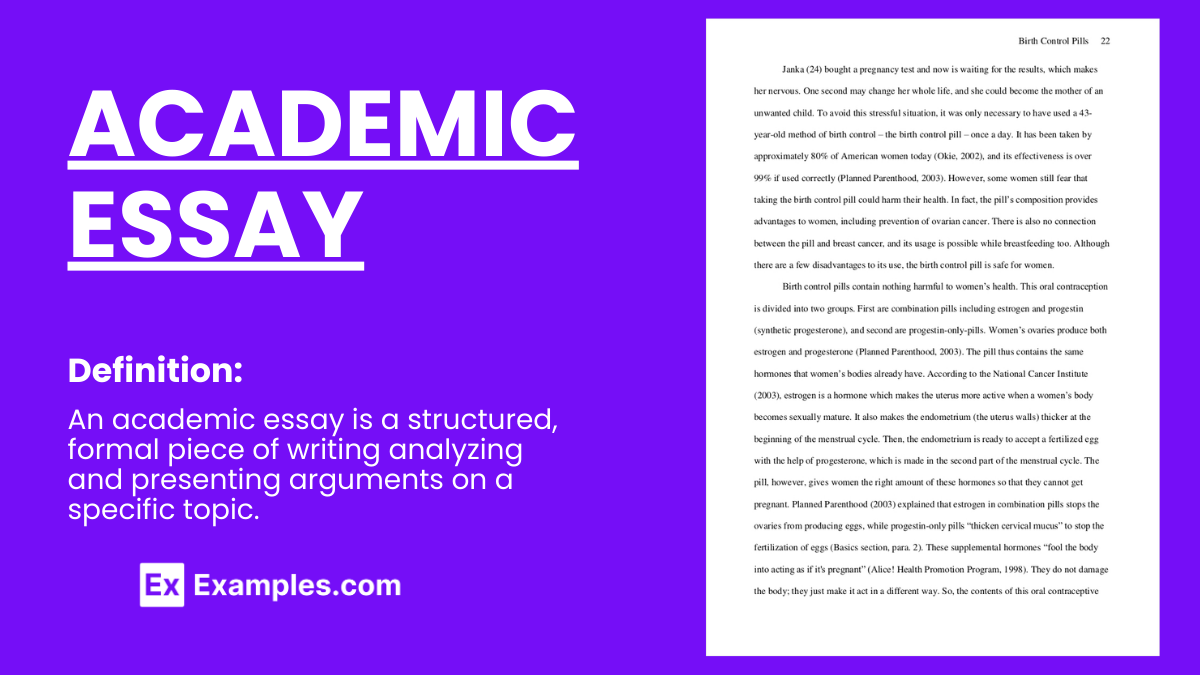
When creating an academic essay , it is very important for you to relay a sensible and clear argument to your target readers. Since academic essays are widely used in the field of education and research, you need to ensure that you do both logical, interesting and informative writing . The items that are commonly seen in an academic essay contain insights, actual occurrences, ideas, and facts.
What is Academic Essay?
An academic essay is a structured form of writing that serves the purpose of presenting and supporting a thesis or argument on a specific topic. It is commonly used in educational settings to assess students’ understanding, analytical skills, and ability to research and convey their findings. An academic essay typically follows a clear format, including an introduction with a thesis statement, body paragraphs that provide evidence and analysis to support the thesis, and a conclusion that summarizes the main points and reinforces the essay’s central argument. This type of essay requires critical thinking and a formal tone, with evidence cited from reputable sources to back up claims made within the text.
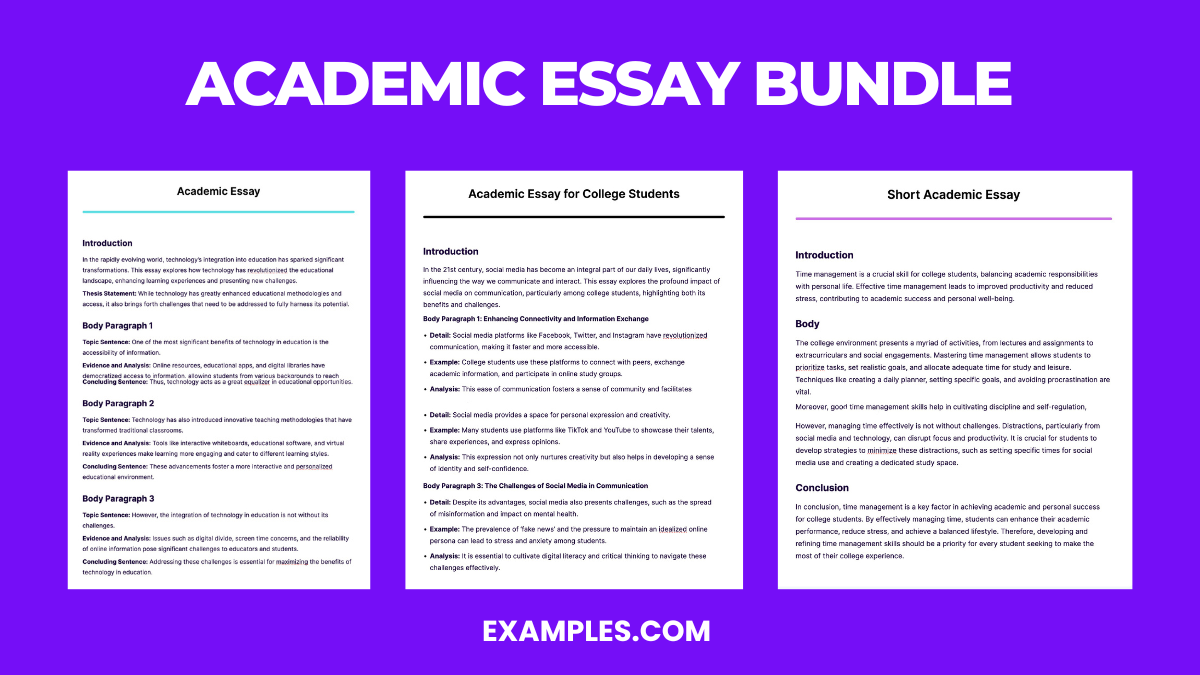
Download Academic Essay Bundle
A lot of students tend to think that an academic essay, just like any other college essay , is something that is too technical or defined. However, you can always write one depending on how you perceive a specific topic of discussion or how you interpret an instance or any other subjects. The samples that we have for you can be a great help if you would like to start writing your academic essay already.
Academic Essay Writing Format/ Outline
1. title page (if required).
Includes the essay’s title, the author’s name, and institutional affiliation.
2. Introduction
Hook : Opens with a statement to grab the reader’s interest. Background Information : Provides context for the topic being discussed. Thesis Statement : Presents the main argument or claim of the essay.
3. Body Paragraphs
Each paragraph should focus on a single idea that supports the thesis, structured as follows:
Topic Sentence : Introduces the main idea of the paragraph. Evidence and Analysis : Includes data, quotes, or examples to support the topic sentence, followed by an explanation of how this evidence supports the thesis. Transition : Connects to the next paragraph or idea.
4. Conclusion
Summary of Main Points : Restates the key arguments or findings presented in the body paragraphs. Restatement of Thesis : Reinforces the essay’s main argument in light of the evidence presented. Closing Thought : Offers a final insight, a call to action, or a suggestion for further research.
Example of Academic Essay Writing
The Impact of Social Media on Communication In the digital age, social media has revolutionized the way we communicate, transcending physical boundaries and transforming social interactions. This essay explores the profound impact of social media on communication, examining both its positive advancements and negative implications. While social media platforms like Facebook, Twitter, and Instagram have enhanced our ability to connect with others, they have also led to a decline in face-to-face interactions and a dilution of personal communication skills. Social media has made it easier than ever to stay connected with friends and family, regardless of geographical distance. A study by Smith and Duggan (2016) found that 75% of internet users utilize social media to maintain relationships with distant family and friends. This widespread use of social media for keeping in touch demonstrates its role as a vital communication tool, bridging the gap between people worldwide. However, the reliance on social media for communication has led to a decrease in the quality of interpersonal interactions. Research by Johnson (2018) indicates a 40% decline in face-to-face conversations among young adults, correlating with increased social media usage. The preference for digital communication over personal interaction suggests a shift in social dynamics, potentially harming relational depth and emotional connections. Moreover, social media has affected our communication skills, particularly among younger generations. A survey by Lee (2019) revealed that 60% of teachers believe social media use has adversely affected students’ writing and verbal communication skills. The informal language and abbreviations common in social media posts and messages are infiltrating academic and professional communications, underscoring the need for a balanced approach to digital interactions. Social media has undeniably transformed communication, offering unparalleled connectivity but also presenting significant challenges. While it fosters global connections, its overuse can undermine personal interactions and communication skills. Balancing social media use with face-to-face communication is crucial for maintaining meaningful relationships and effective communication in the 21st century.
What is an example of academic writing?
Title: The Impact of Climate Change on Biodiversity
Introduction: Climate change, driven primarily by human activities such as the burning of fossil fuels and deforestation, has emerged as a critical global concern. This essay aims to explore the multifaceted impacts of climate change on biodiversity. The effects of rising temperatures, altered weather patterns, and habitat destruction are increasingly evident, with far-reaching consequences for ecosystems and species worldwide.
Body Paragraph: One of the most noticeable consequences of climate change is the shifting geographical ranges of numerous species. Warmer temperatures prompt species to migrate to higher altitudes or latitudes, as they seek habitats that align with their thermal preferences. This phenomenon is evident in various ecosystems, including mountain regions, where alpine plants and animals have progressively moved uphill. These migrations, while adaptive, can disrupt established predator-prey relationships and competition for resources. Such shifts can also lead to reduced biodiversity in lower-altitude regions as some species fail to adapt or relocate successfully.
- Smith, J., & Johnson, A. (2019). Impacts of Climate Change on Alpine Plant Communities. Environmental Studies Journal , 42(3), 256-270.
- Wilson, P., & Davis, R. (2020). Climate-Induced Shifts in Animal Distributions: Evidence from a Decadal Study. Ecology and Evolution , 10(12), 5963-5972.
Conclusion:
In conclusion, climate change exerts profound effects on biodiversity, manifesting through shifts in species distributions, altered ecological relationships, and habitat loss. As global temperatures continue to rise, addressing these impacts becomes increasingly urgent. Conservation efforts, sustainable practices, and international cooperation are essential in mitigating the repercussions of climate change on the world’s diverse ecosystems and species.
Academic Essay Topics with Samples to Edit & Download
- Pollution due to urbanization
- The environmental causes of smoking
- The outcomes of global warming
- Abortion as a controversy
- Causes of obesity in teenagers
- Childhood memories
- Fathers should get equal paternity leave
- Harmful dogs should be euthanized
- How does divorce affects children?
- How does technology affect productivity?
- Importance of preserving threatened species
- Parenting styles and motives
- Political issues in the U.S.
- Romantic relationships
- Should schools abolish homework?
- Violent video games should be banned
- Ways of protecting the environment
Academic Essay Writing Examples & Templates
1. academic essay example.
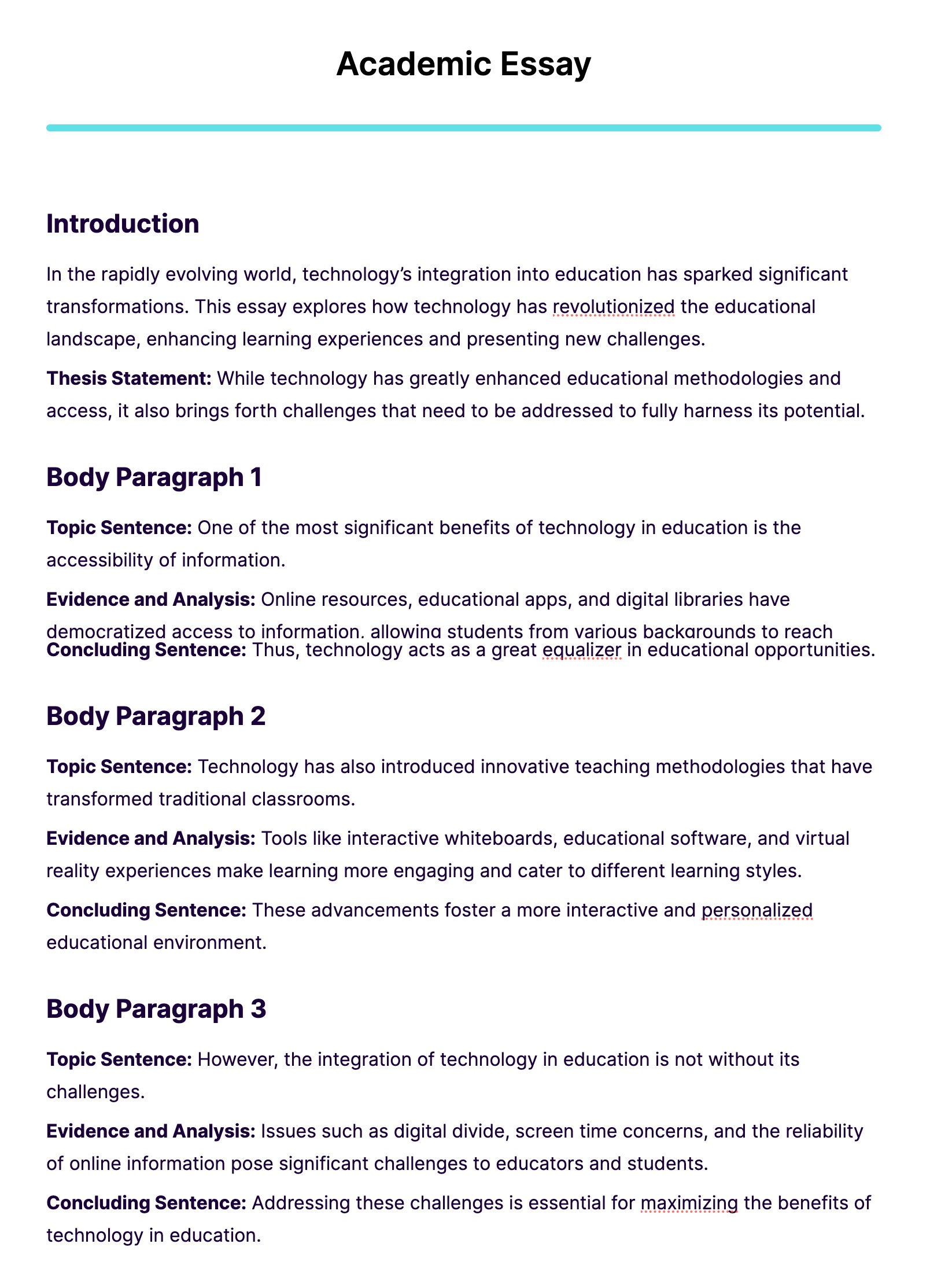
Free Download in PDF
2. Academic Essay for College Students
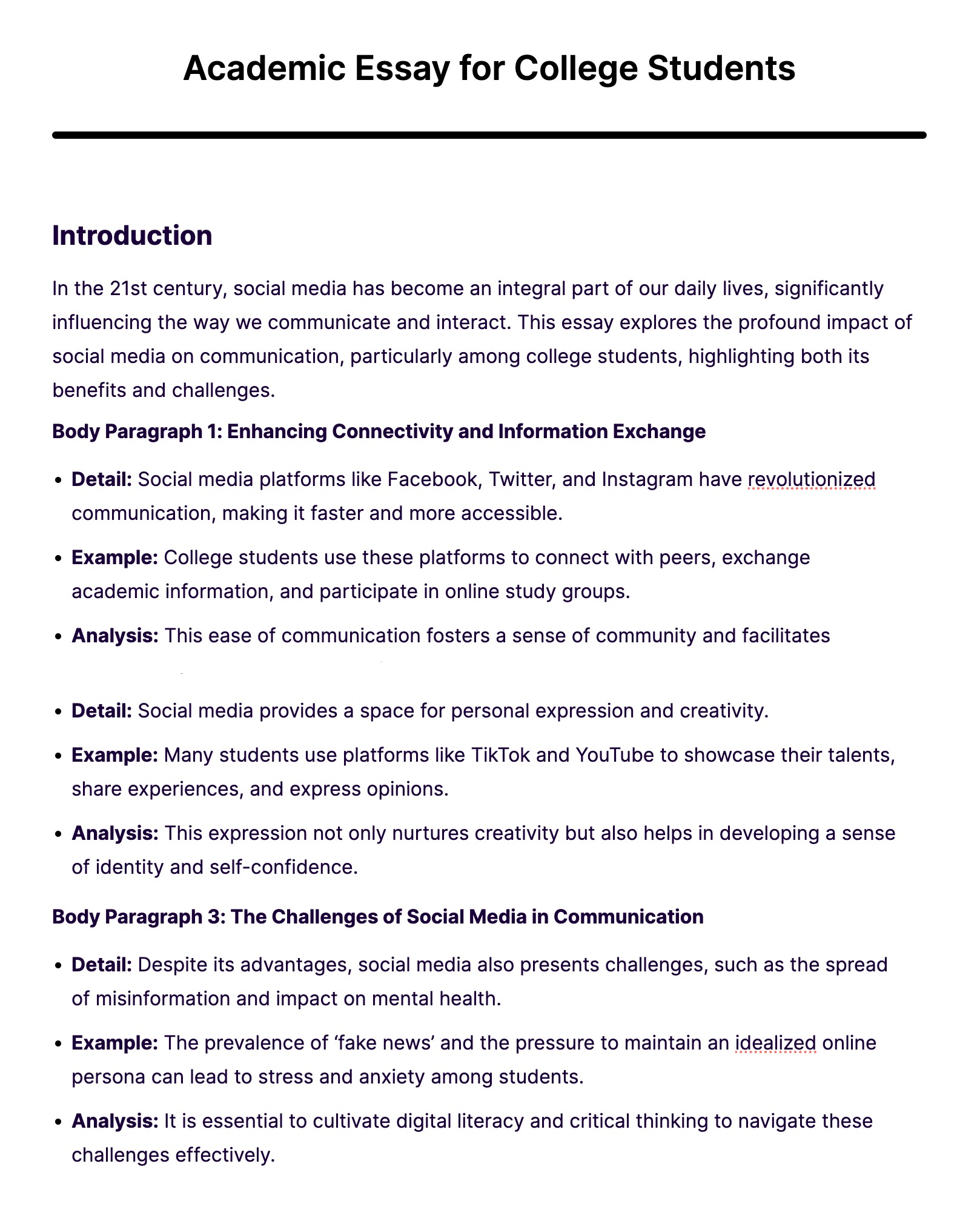
Edit & Download
3. Short Academic Essay
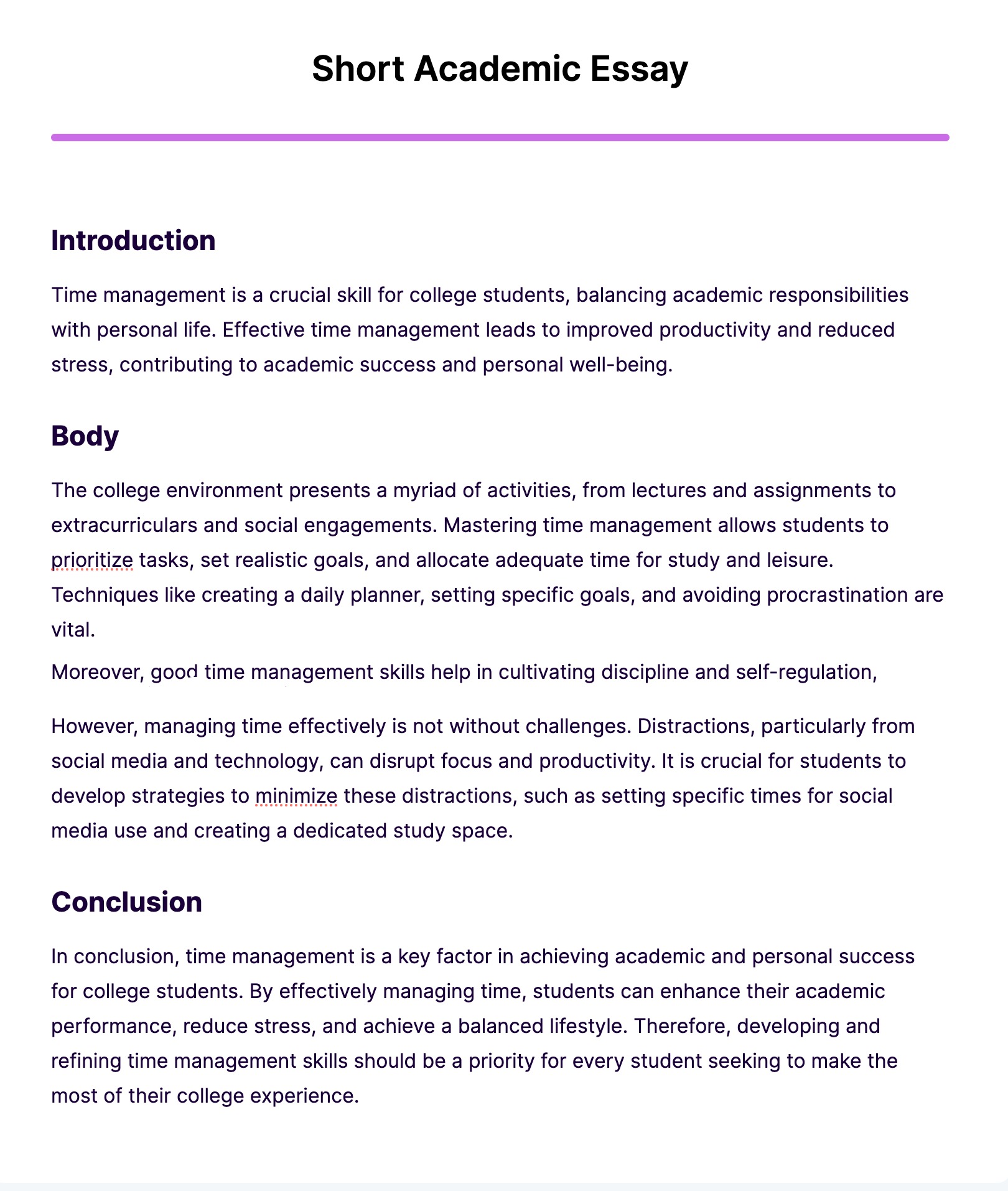
4. Academic Essay Template
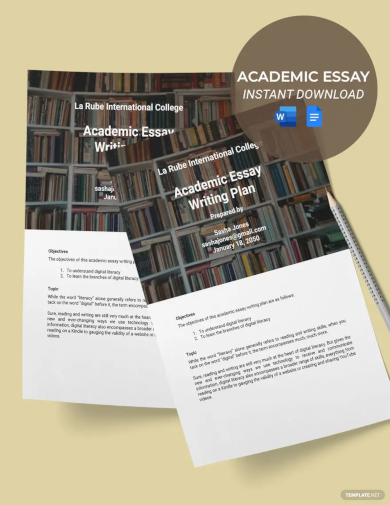
5. Academic Writing Essay Template
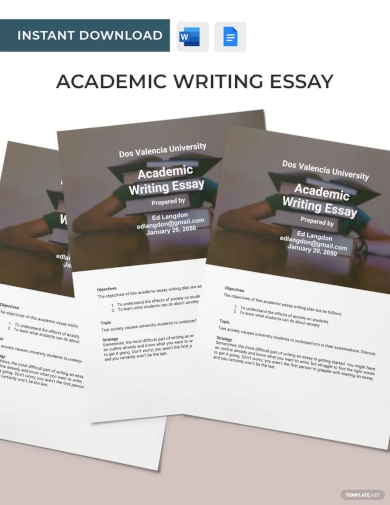
6. Academic Text Example Essay Template
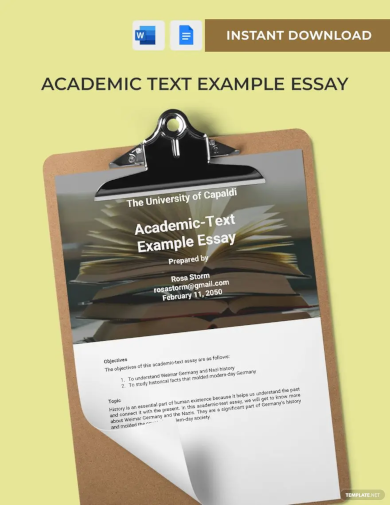
7. Academic Essay Writing Examples
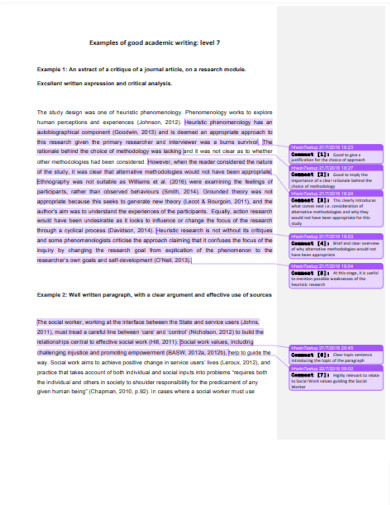
academic-skills.health.herts.ac.uk
8. Academic Essay for College Students Examples

9. Narrative Academic Essay Examples
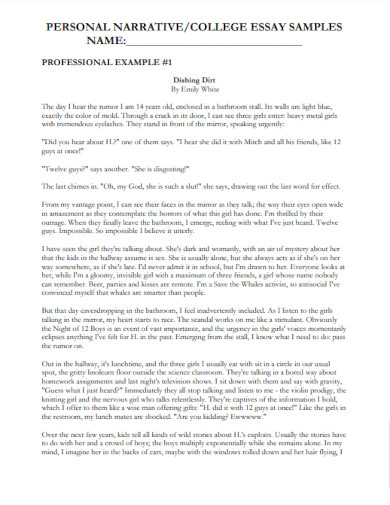
learning.hccs.edu
10. Sample Academic Essay Format Example

owll.massey.ac.nz
11. Academic Paper Essay Example
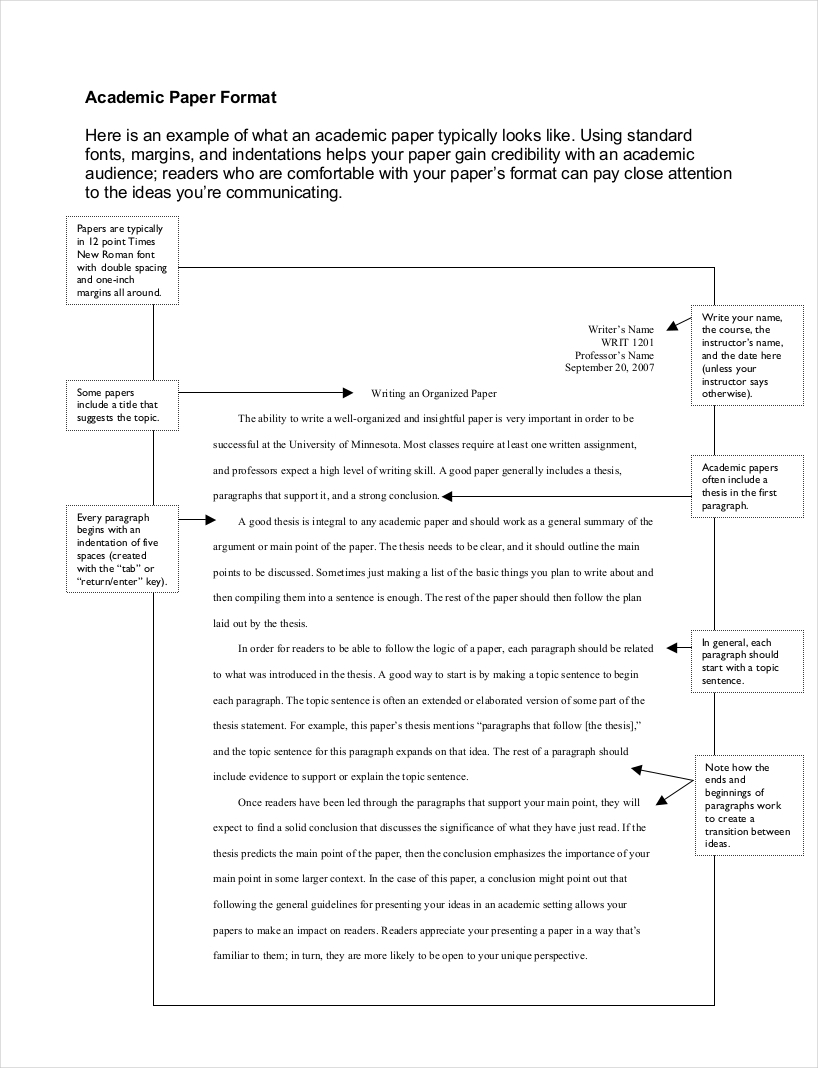
writing.umn.edu
12. Simple Academic Essay Example
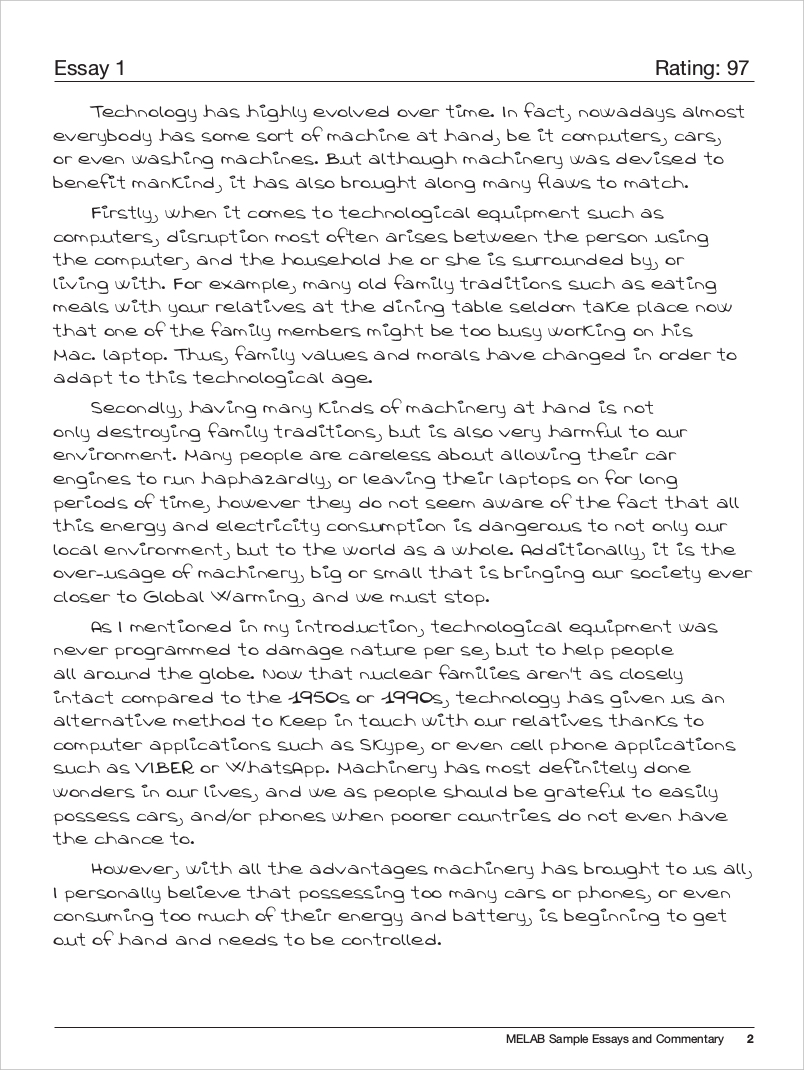
cambridgemichigan.org
13. Academic Essay Sample Structure Example
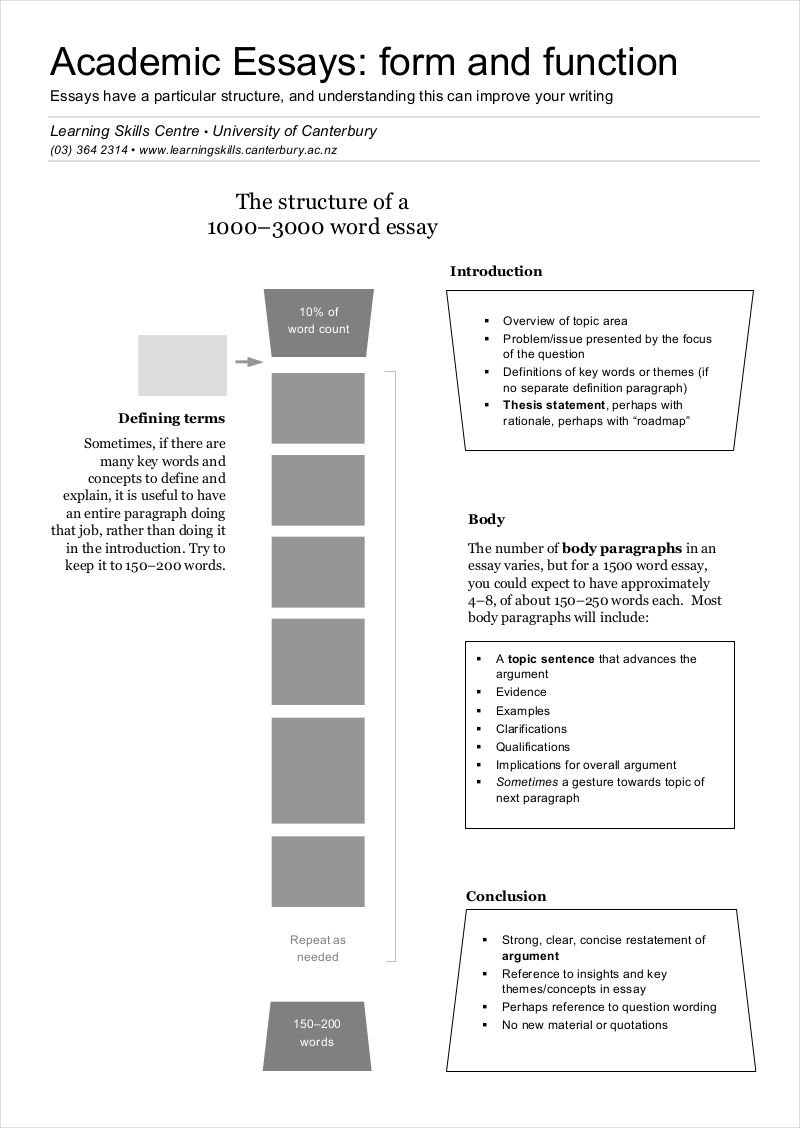
lps.canterbury.ac.nz
14. Short Academic Essay Example in PDF
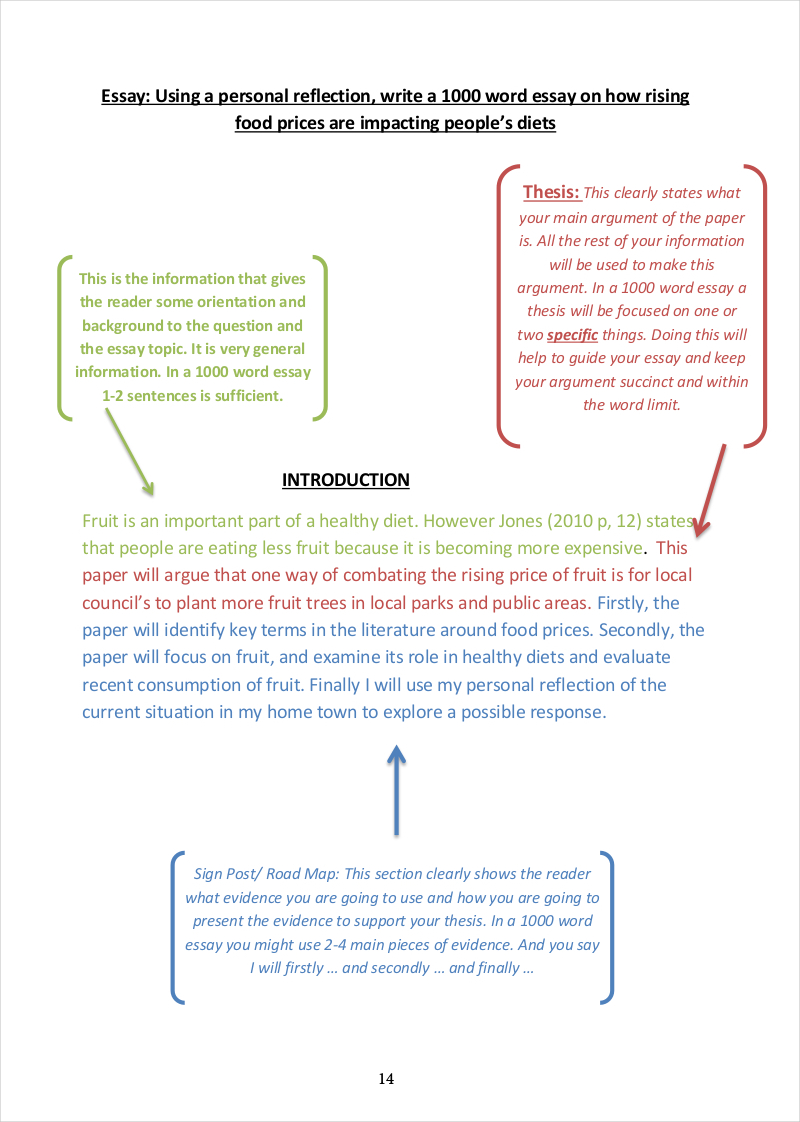
15. Free Printable Academic Essay Sample
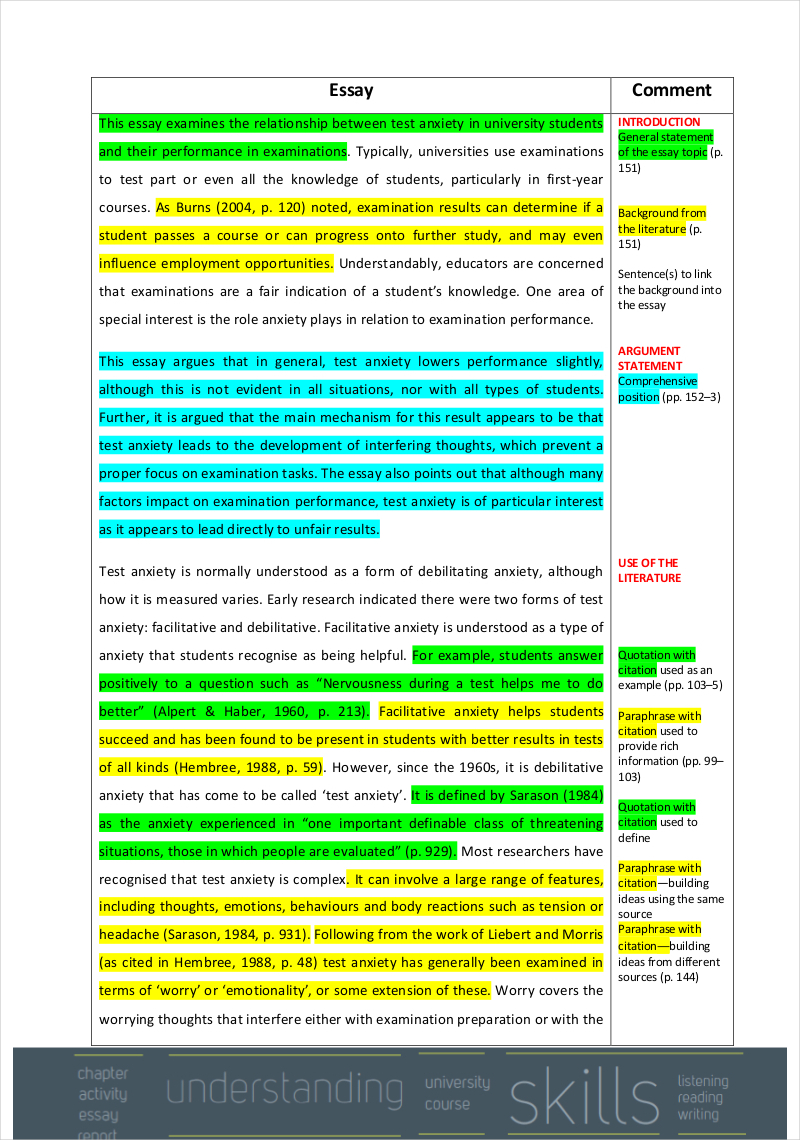
lib.oup.com.au
16. Sample Academic Essay Example
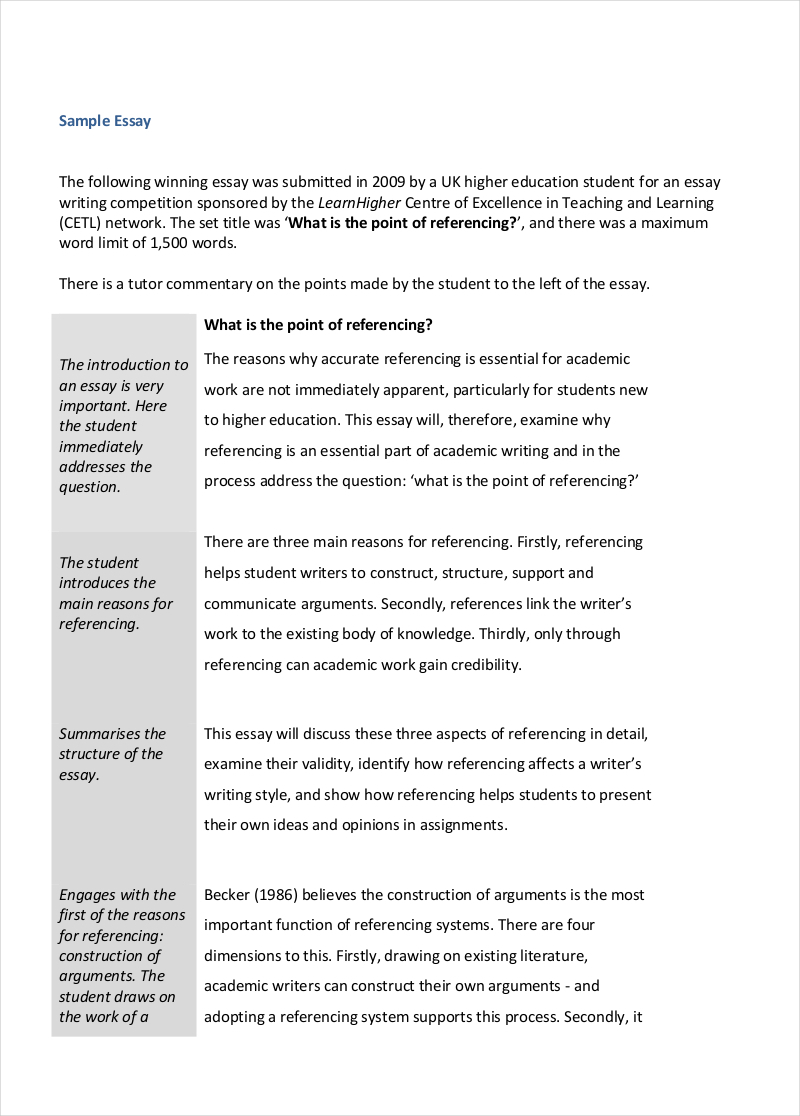
17. Academic Essay Writing Sample Example
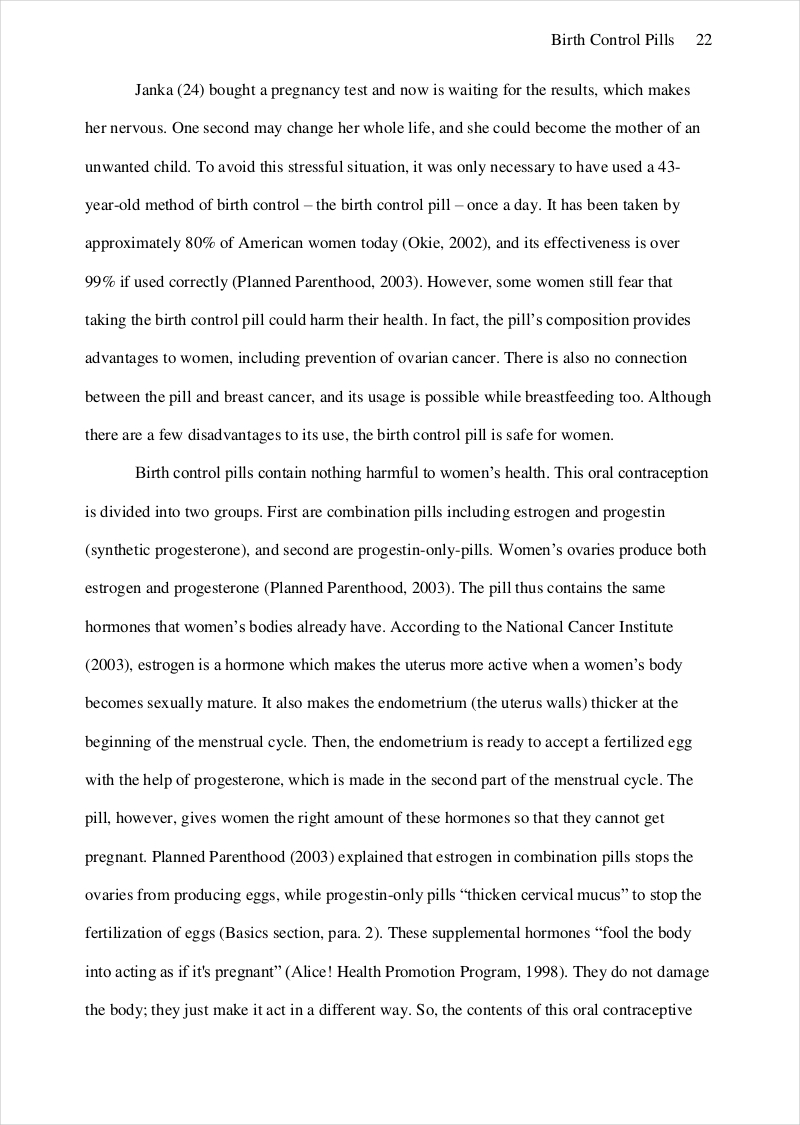
18. Free Academic Essay Sample Guide

intranet.ecu.edu.au
19. Sample Academic Essay Outline
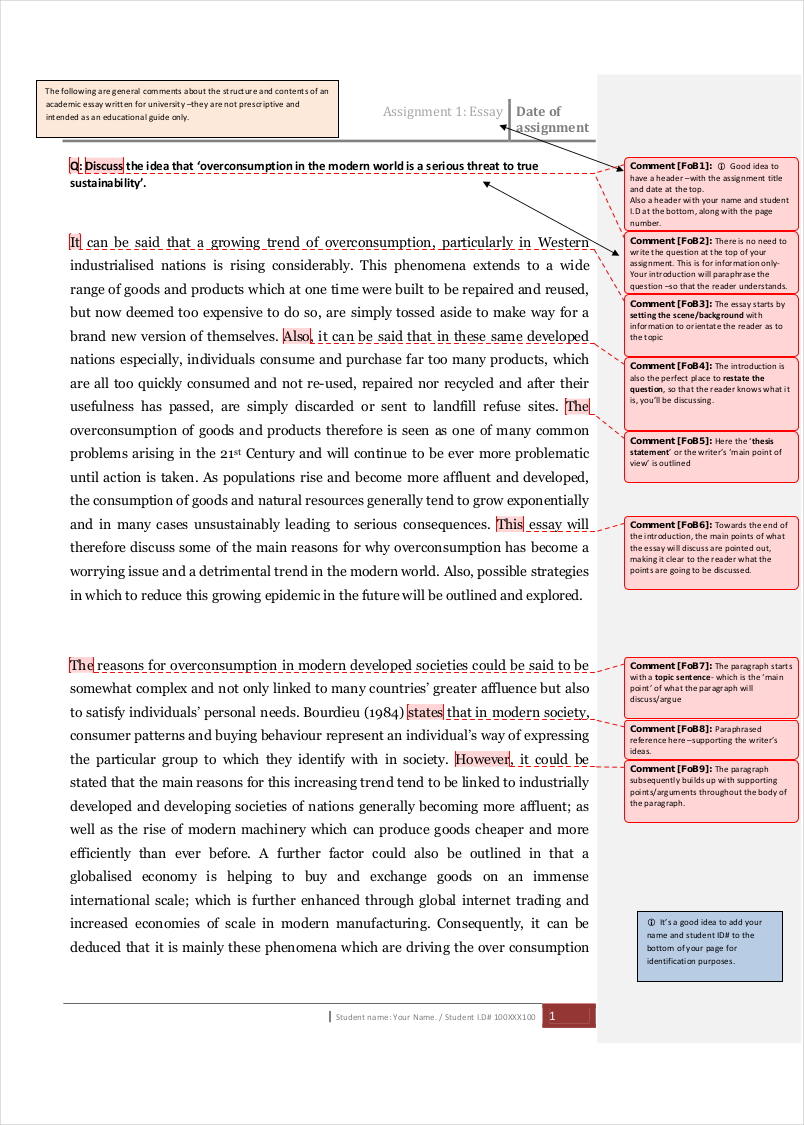
lib.uts.edu.au
Are You Ready and Prepared to Create an Academic Essay?
Different types of academic writing require an individual to have a clear thought process within the entirety of idea development. You have to be focused on what you would like to achieve your final written output so you can incorporate successful guides and processes within the activity. Some of the things that you can talk about in an academic essay include the following:
- Human behavior, characteristics, and emotions
- Community relations
- Natural occurrences
- Language and its effective usages
- Culture and the arts
- Academic researchers
- Relevant cultural phenomenon
- Photography and other artistic undertakings
- Human interactions
- Other subjects that are related to education and academics
Knowing the subject of your article is only one of the initial things that can help you prepare during the writing process. Here are some ways on how you can be ready to write your academic essay:
- You need to have an order of writing that can easily showcase the flow of your thoughts. You must ensure that you can easily connect with your readers or audience so they can respond to the content of your article. Your academic essay should evoke an emotion that is necessary to spark other ideas, opinions and other kinds of responses.
- You need to be aware that academic essays differ depending on the educational or academic discipline where they will be used. There are certain ways that are necessary to be followed in various fields for an academic essay to be deemed effective. With this, always be mindful of the directions or instructions were given to you by the entity who requires you to write an academic essay.
- You do not need to pattern your writing to the works of others. You can be ready even by just knowing your subject and researching about it. The style of writing that you have can give the most difference to how you write and how you present your work. Always keep in mind that your academic essay should be playful – it must not bore your audience.
- You must think of your academic essay as an enterprise by using scholastic writing approaches. The conversation that you can create with your readers must be relevant to what is happening nowadays or for the study that specific student groups need. Being able to give focus on the relativity of your written work can make it easier for readers to understand why your academic essay is important within the academic field.
- You should ensure that your thesis statement is precise, concise, and strong. When you are in the process of developing your academic essay’s thesis, you need to make sure that you are not just basing your write-up on unreliable information. Always refer to evidence, facts, and real data as it can help you strengthen your claims. More so, do not forget to reference your essays when necessary.
Things to Remember When Identifying the Purpose of Your Academic Essay
An academic essay always has to be relevant. It needs to be beneficial to a specific group or to the majority of the academic community. The motive of your essay is very important to be considered as it can identify whether you can be of help to the people who need a particular educational reference. Here are a few things that you need to remember when identifying the purpose of your own academic essay:
- Do not create an academic essay just for the sake of passing it. Your academic essay is more than an assignment or a project. There are some last minute essay writing activities that are done in various fields especially if students think that an academic essay is just a part of their requirements. However, what these students do not know is that an academic essay is a representation of themselves. It showcases the thoughts of the students, what they have learned may it be in class or through self-discovery, and how they are impacted by certain issues and subjects of discussion. This is where the value of a Free Essay and an Informative Essay becomes evident, as both types of essays encourage students to express their understanding and insights on a given topic freely and informatively.
- Be precise with the purpose of your writing. An academic letter is not just a document that can showcase your mastery when it comes to a particular academic subject. It can talk about a specific subject or it can also be a general paper that can provide a lot of information about your experiences and/or insights. This is where the importance of a Self-Introduction Essay comes into play, allowing you to present a personal narrative that reflects your academic journey and achievements. Similarly, an Expository Essay helps in laying out facts and an unbiased analysis of a topic, further enriching the academic discourse. If you will have a precise purpose when writing an academic essay, there is no doubt that your essay will not be pointless.
- Always think of the best case that can help you represent your thoughts. Your style of writing, as well as the entire document’s format and content, can help you realize your ideas. This includes the succinctness and clarity often found in a Short Essay , where the challenge is to convey your thoughts within a limited word count effectively. Similarly, a Scholarship Essay requires you to articulate your achievements and aspirations in a way that resonates with scholarship committees, demonstrating your potential and need for financial support. With this, your point of writing can easily be identified by readers. Being able to present your purpose the best way possible can add up to the success of your academic paper.
Developing an Academic Essay
For you to be able to persuade your readers with the content of your academic essay, there is a need for you to present a structure that can easily identify your claims, arguments, observations, and/or factual presentations. Integrating a Student Essay can demonstrate the personal perspective or learning journey of an individual, making your arguments more relatable. Similarly, incorporating a Travel Essay could enrich your essay by providing unique insights and observations from different cultures or environments. Being clear about how you present your idea is essential for people to see the context of your academic essay.
If you have an organized manner of putting together the concepts of your academic essay, then validating your thesis statement can be more evident. To avoid common essay mistakes and other negative factors that can affect your desired output, here is a basic guide on how you can develop your own academic essay:
- Start by creating a strong thesis statement. Identify your stand and make sure to strictly present evidence that can help you claim its authenticity and validity. Reveal evidence after your thesis statement presentation. Your thesis statement serves as your introduction speech . It lets your readers know the topic of your academic essay and what they can expect from the entire article.
- Establish the context of your essay after your thesis statement. The way that you approach your topic can let readers know whether it is the specific approach that they also need for their undertakings. There are different contexts that can be used within the same subject, so you have to make sure that you will be clear when it comes to identifying the part of the topic that you are going to talk about. This clarity can be achieved through a Descriptive Essay , where vivid descriptions and details about the topic can enlighten and engage the reader. Additionally, understanding the Parts of an Essay is crucial in structuring your thoughts and arguments effectively. Limiting your topic discussion can help you give more focus to what is important for your discussion, ensuring that each part contributes meaningfully to the whole.
- Create the next paragraphs based on the data that can support your thesis statement. The body of your academic essay can be based on your observations, reviews, statements and research outputs. You can present these items separately through the usage of various paragraphs. However, there are instances where it will be better if you can combine or compare to evidence to make your statements more effective.
- Conclude. Your conclusion is as important as your introduction. If you believe that you have created a strong introduction, you have to maintain that until the end of your academic essay. Sum up all the information that you have presented so that people can identify whether your conclusion has lived up to the content of what you have written. Your conclusion can also be used to assess whether your thesis statement has been carried within the entirety of your discussion.
Importance of a Well-Defined Thesis Statement in an Academic Essay
A thesis statement is a paragraph or a set of paragraphs that identifies your stand about your subject. There is a need for this statement to be created as it can affect the entirety of your academic paper. Here are some of the reasons why it is important to develop an effective thesis statement before and while writing your academic paper:
- Your thesis statement is a reflection of your actual idea. This helps you present the point that you would like to make and the message that you actually want to disseminate to your readers. Through a thesis statement, you can organize the evidence that are relevant to your claims based on their relevance to the topic and how you view it as a writer.
- Your thesis statement can guide you within the entirety of your writing processes. Just because you have already done an initial thesis statement does not mean that you are going to fully stick with it until the end of your writing. There are instances where thesis statements are developed or even changes during the creation of an academic essay depending on how the research about the topic has evolved.
- Your thesis statement can allow you to establish originality. Since your academic essay can be based on your research findings and observations, your thesis statement can be your platform to specify what you have come up with. Through a well-defined thesis statement, you can set your output apart from other essay examples that have been written by professionals and other entities in the field of academics.
- Your thesis statement is one of the items that the audience will look at when referencing for credibility and validity. Academic essays need to have a strong initial impact on readers. This statement can help them be focused on a particular standpoint which can enlighten them about your views and opinions, and how these are essential to be considered.
- Your thesis statement can help your readers immerse in your academic essay. The material that you will be coming up with can be reviewed by different people. Depending on the field of education where you are currently in, you need to make sure that your readers can see patterns of evidence presented so they can clearly see how you were able to generate and come up with insights. You have to ensure that the thesis statement that you have created contains the most promising thought so you can get the trust or even the acceptance of your readers about your academic essay’s subject.
Guidelines in Writing an Academic Essay
The course materials that you need to talk about within an academic essay can reflect your level of understanding about the subject. Simply put, an academic essay can be an evidence of the depth of your research procedures and all the other activities that you have executed so that you can support the content of your written output. Listed below are some of the guidelines that can be useful to your academic essay writing processes.
- Always analyze your essay prompt or the question that you need to answer or explain. You have to know whether you are tasked to argue, analyze, or discuss the topic. There will be times where you also need to compare the items present in your subject or explain the underlying factors that can affect your topic.
- Make sure that you will research about what you will write about . Your academic essay can only be fully-maximized if you can present facts. Primary research may be a helpful bit a more precise review of your research topic can help you gather more information that can be helpful in the development of your content. Always assess your sources of information so you can ensure that they are credible.
- Create a draft so that you will have a guide when writing your academic essay. If you will be organized when writing your academic essay, you can create an output that is well-curated and comprehensive. With this, your academic essay can provide more impact to your readers. This can also help you gather your thoughts first and identify how you can put them all together in the most cohesive and efficient way possible.
If you still do not feel confident in writing your own academic essay from scratch, then you can refer to templates and samples which you can download online. Doing this will allow you to be more familiar with the common content and basic formats that are usually seen in an academic essay. When using a template as a guide, always make sure that it is applicable to the study that you are practicing or the academic field or discipline where you will use your academic essay.
As a student, there will always be an instance where we will be required to write an academic essay. If you want to create an academic essay that is both outstanding and relevant, always put the items that we have discussed above in mind.
Setting the Stage for Essay Writing Success
- Understand the Assignment: Carefully read and comprehend the essay prompt or assignment to grasp its requirements and objectives.
- Topic Selection: Choose a relevant and interesting topic that aligns with the assignment.
- Research: Gather credible sources and information related to your topic. Take thorough notes and document your sources.
- Thesis Statement: Develop a strong, clear, and concise thesis statement that presents the main argument of your essay.
- Outline: Create an outline that organizes your essay into sections, including the introduction, body paragraphs, and conclusion. Each section should have a clear purpose.
- Writing Draft: Begin writing your essay, keeping the introduction engaging, and ensuring each body paragraph addresses a single point or idea supported by evidence.
- Citations: Properly cite sources as you write, following a recognized citation style (e.g., APA, MLA).
- Edit and Revise: Review and revise your draft, focusing on grammar, clarity, coherence, and organization.
- Proofread: Carefully proofread your essay for errors in spelling, punctuation, and sentence structure.
- Final Review: Double-check that your essay fulfills the assignment requirements, including formatting, citations, and references.
How do you write an academic essay?
- Understand the Assignment: Read the essay prompt or assignment thoroughly to grasp its requirements and objectives.
- Research: Gather relevant sources and information from books, articles, and credible online sources.
- Plan and Outline: Create an outline with an introduction, body paragraphs, and a conclusion. Each section should have a clear purpose.
- Thesis Statement: Develop a strong thesis statement that presents the main argument of your essay.
- Introduction: Start with a compelling hook, provide background information, and present your thesis statement.
- Body Paragraphs: Each paragraph should focus on a single point or idea, supported by evidence or examples. Use topic sentences to introduce the main idea of each paragraph.
- Citations: Cite sources properly using a recognized citation style (e.g., APA, MLA, Chicago).
- Analysis and Critical Thinking: Analyze and evaluate the evidence or arguments presented, and make connections between them.
- Transition Sentences: Use transition words and phrases to connect ideas between paragraphs.
- Conclusion: Summarize the main points, restate the thesis, and provide a thoughtful conclusion that leaves a lasting impression.
Academic Essay Characteristics
Academic essays are distinguished by several key characteristics that set them apart from other types of writing. These features ensure that essays meet the rigorous standards of academic discourse and contribute effectively to scholarly conversations. Here are the primary characteristics of academic essays:
- Clear Purpose : An academic essay is written with a clear purpose, often to argue a point, present an analysis, or discuss a research finding. The purpose guides the structure and content of the essay.
- Structured Format : It follows a structured format with an introduction, body paragraphs, and a conclusion. This organization helps present arguments and evidence in a coherent and logical manner.
- Thesis Statement : A distinctive feature is the thesis statement, a concise summary of the main argument or claim, usually found at the end of the introduction. It sets the direction for the entire essay.
- Critical Analysis : Academic essays involve critical analysis of ideas, texts, or situations. Writers assess evidence, debate viewpoints, and use logic to develop their arguments.
- Evidence-Based Arguments : Claims made in academic essays are supported by evidence from credible sources. This includes data, statistics, research findings, and quotations from experts.
- Formal Tone and Style : The writing adopts a formal tone and style, avoiding colloquial language, personal anecdotes (unless relevant), and slang. It maintains an objective and professional voice.
Types of Academic Writing
Academic writing encompasses a variety of types, each serving a specific purpose and adhering to a particular format. Here are some of the main types of academic writing:
- Descriptive Writing : This type focuses on describing a character, event, or situation in detail. It’s often used in reports or descriptive essays, where the goal is to provide a clear picture of the subject to the reader.
- Analytical Writing : Analytical writing breaks down complex information into smaller components for better understanding. It involves comparing and contrasting, classifying, and analyzing causes and effects. This type is common in research papers and literature reviews.
- Persuasive Writing : Persuasive writing aims to convince the reader of the writer’s viewpoint or argument. It is characterized by a strong thesis statement, clear evidence, and logical reasoning to persuade the reader. Opinion pieces, argumentative essays, and proposals often employ persuasive writing.
- Expository Writing : Expository writing is used to explain or inform the reader about a specific topic in a clear, concise, and logical manner. It focuses on presenting facts, statistics, and examples without the writer’s personal opinions. This type includes most essays, many types of reports, and certain types of research papers.
- Reflective Writing : This type involves the writer reflecting on their personal experiences, thoughts, or feelings regarding a particular subject or experience. Reflective writing is subjective and is often used in journals, blogs, and reflection essays in educational settings.
- Critical Writing : Critical writing evaluates and critiques the work of others, such as books, articles, or artworks. It involves assessing the strengths and weaknesses of arguments, evidence, and methodologies. Literature reviews, critique essays, and certain types of research papers often require critical writing.
- Narrative Writing : Although less common in strict academic settings, narrative writing is used in certain disciplines to tell stories or describe events chronologically. Personal statements and some types of qualitative research may employ narrative writing to convey experiences and observations.
- Report Writing : Reports convey information from a writer to a reader, focusing on facts and evidence. They are structured and include sections like an introduction, methodology, findings, and conclusions. Lab reports, business reports, and technical reports are examples of this type.
Academic Writing Principles
Academic writing is governed by a set of core principles designed to ensure clarity, precision, and rigor in scholarly communication. Understanding and adhering to these principles is essential for effective academic writing. Here are the key principles:
- Clarity : Writing should be clear and understandable, avoiding unnecessary jargon and complexity to ensure that the reader can easily follow the argument or narrative.
- Coherence : The text should be logically organized, with a clear structure that guides the reader through the argument or discussion. Each part of the writing should connect to the others in a meaningful way.
- Conciseness : Academic writing should be concise, conveying ideas in as few words as necessary. This does not mean oversimplifying, but rather avoiding redundancy and verbosity.
- Objectivity : Writers should strive for objectivity, presenting information and arguments based on evidence rather than personal opinions or biases. This includes acknowledging counterarguments and limitations.
- Precision : Precision involves using the exact words to convey your meaning and being specific about your claims, evidence, and references. This also means accurately citing sources and providing specific data when necessary.
- Evidence-Based Argumentation : Arguments should be supported with appropriate evidence, such as data, examples, and citations from authoritative sources. This principle underscores the importance of research and verification in academic writing.
- Formality : The tone of academic writing is formal, which means avoiding colloquial language, contractions, slang, and humor. Formality also involves using the passive voice where appropriate and avoiding personal pronouns when making general arguments.
- Citation and Referencing : Proper citation and referencing of sources are fundamental to academic writing. This practice not only gives credit to original authors but also allows readers to verify sources and understand the basis of the evidence presented.
- Originality and Plagiarism Avoidance : Academic writing must be original and free from plagiarism. This means that writers should produce their own work based on their research and ideas and appropriately cite any sources they use.
- Critical Thinking : Effective academic writing reflects critical thinking, challenging assumptions, evaluating evidence, and synthesizing ideas from various sources to offer new insights or perspectives on a topic.
How do you start an academic essay sample?
Begin an academic essay sample with a captivating hook, provide context on the topic, and conclude the introduction with a clear and concise thesis statement that outlines your main argument.
What is the opening line of an academic essay?
The opening line of an academic essay should engage the reader’s interest, introduce the topic, and provide a sense of the essay’s focus and importance.
What not to write in an academic essay?
In an academic essay, avoid personal opinions, emotional language, unsubstantiated claims, informal language, and plagiarism. Focus on evidence-based arguments and adhere to academic standards and conventions.
How do you write an academic essay quickly?
To write an academic essay quickly, start with a clear thesis, outline main points, research efficiently, focus on key evidence, and minimize editing while maintaining proper citations and structure.
Text prompt
- Instructive
- Professional
Write an academic essay on the impact of technology in education
Explain in an academic essay how climate change affects global agriculture
Unveiling the Power of Storytelling: what a Narrative is
This essay about the profound role of storytelling explores its components, such as characters and plot, and its effects on culture and personal identity. It discusses how narratives evoke emotions, reflect societal norms, and aid in education. The text also examines the transformation of storytelling through digital technologies, highlighting its impact on cultural exchanges and communication across various disciplines. The significance of narratives in shaping personal and collective identities and their utility in various fields is underscored.
How it works
Storytelling, an intrinsic human practice, transcends mere entertainment, embodying a profound method of communication that connects individuals, delineates cultures, and shapes our understanding of the world. A narrative, at its essence, is a coherent sequence of events populated by characters, unfolding through intricately devised plots to engage and impact its audience. This exploration of narrative power sheds light on its components, effects, and significance in influencing thought and culture.
A narrative typically comprises characters, a plot, and a setting, all woven together to craft a story that captivates its audience.
Characters are the soul of the narrative, humanizing the story and allowing the audience to see a reflection of themselves or explore new perspectives. These characters might range from people to mythical creatures, all crafted to evoke connection and empathy. The plot represents the skeleton of the narrative, outlining the critical events that propel the story from commencement to conclusion, thereby shaping the trajectory and pace of the narrative.
The true power of storytelling lies in its ability to stir emotions and develop empathy. As audiences immerse themselves in narratives, they often experience a spectrum of emotions, aligning their feelings with those of the characters. This emotional engagement is not mere coincidence but a crafted aspect of the narrative, designed to enhance the relatability and memorability of the story, thus amplifying its impact on the audience.
Narratives also act as societal reflections, offering insights into the cultural mores, issues, and conflicts of a community. Storytellers can subtly or overtly critique or uphold societal norms, thereby influencing public discourse and opinion. This reflective capacity of narratives makes them invaluable tools for both preserving cultural identity and advocating for change. Stories not only transmit historical and cultural knowledge but also adapt and evolve to incorporate new ideas and perspectives.
Furthermore, narratives play a pivotal role in shaping personal and collective identities. Through personal stories and public narratives, individuals and communities construct identities that define their roles and values within a societal context. Personal narratives, like autobiographies, help individuals make sense of their past experiences, while collective narratives unite groups with common histories and values, fostering a sense of community and continuity.
In education, narratives simplify complex ideas and enhance recall, making learning more accessible and engaging. Educational stories often use metaphors or hypothetical scenarios to convey complex issues, helping students to better understand and retain abstract concepts.
With the advent of digital technology, the landscape of storytelling has transformed, incorporating interactive and multimedia elements that enrich the narrative experience. Platforms like social media have revolutionized narrative dissemination, enabling anyone to share their stories with a global audience and engage in cultural exchange on an unprecedented scale.
Recognizing the essence and influence of narratives is crucial for appreciating not only the arts but also the daily exchanges that shape our experiences and relationships. Mastering narrative skills is invaluable across diverse disciplines, from therapy and education to marketing and media. As we continue to explore and push the boundaries of narrative possibilities, we open up new avenues for understanding, connecting with others, and shaping societal narratives for future generations.
Cite this page
Unveiling the Power of Storytelling: What a Narrative Is. (2024, May 12). Retrieved from https://papersowl.com/examples/unveiling-the-power-of-storytelling-what-a-narrative-is/
"Unveiling the Power of Storytelling: What a Narrative Is." PapersOwl.com , 12 May 2024, https://papersowl.com/examples/unveiling-the-power-of-storytelling-what-a-narrative-is/
PapersOwl.com. (2024). Unveiling the Power of Storytelling: What a Narrative Is . [Online]. Available at: https://papersowl.com/examples/unveiling-the-power-of-storytelling-what-a-narrative-is/ [Accessed: 13 May. 2024]
"Unveiling the Power of Storytelling: What a Narrative Is." PapersOwl.com, May 12, 2024. Accessed May 13, 2024. https://papersowl.com/examples/unveiling-the-power-of-storytelling-what-a-narrative-is/
"Unveiling the Power of Storytelling: What a Narrative Is," PapersOwl.com , 12-May-2024. [Online]. Available: https://papersowl.com/examples/unveiling-the-power-of-storytelling-what-a-narrative-is/. [Accessed: 13-May-2024]
PapersOwl.com. (2024). Unveiling the Power of Storytelling: What a Narrative Is . [Online]. Available at: https://papersowl.com/examples/unveiling-the-power-of-storytelling-what-a-narrative-is/ [Accessed: 13-May-2024]
Don't let plagiarism ruin your grade
Hire a writer to get a unique paper crafted to your needs.

Our writers will help you fix any mistakes and get an A+!
Please check your inbox.
You can order an original essay written according to your instructions.
Trusted by over 1 million students worldwide
1. Tell Us Your Requirements
2. Pick your perfect writer
3. Get Your Paper and Pay
Hi! I'm Amy, your personal assistant!
Don't know where to start? Give me your paper requirements and I connect you to an academic expert.
short deadlines
100% Plagiarism-Free
Certified writers
Here’s How Ivy League Schools Evaluate Student GPAs
- Share to Facebook
- Share to Twitter
- Share to Linkedin
One of the main gates on the Brown University campus, decorated with the University crest. (Photo by ... [+] Rick Friedman/Corbis via Getty Images)
A stellar GPA is one of the building blocks of a successful Ivy League application, and as the school year winds down, many students are anxiously seeking to give theirs a final boost. While most students and families understand the importance of a 4.0, few are aware of how top colleges evaluate student GPAs or what they look for when reviewing student transcripts. Though your GPA may seem to be a simple metric, nothing could be further from the case—colleges consider more than just the number, accounting for complexities such as diverse grading systems across schools, trends in grade inflation, and level of course rigor.
Here are three important facts to keep in mind about your GPA as you choose your courses:
1. Your GPA doesn’t directly compare to that of students at other schools.
One common misconception among college applicants is that they can compare their GPAs with those of students attending different schools. However, the GPA is not a universal metric but rather a reflection of an individual's academic performance within their specific educational environment. As a result, comparing GPAs from different schools is like comparing apples and oranges. For instance, some schools offer a plethora of AP, IB, and honors courses, while others may have limited options or offer none at all. Additionally, the weight assigned to AP versus honors versus regular classes varies from school to school. So, your GPA may not hold the same weight as those of your peers at different schools, even if you all have 4.0s.
Admissions officers understand that schools vary in their rigor, curriculum, and grading policies. Therefore, they evaluate your GPA in the context of your high school, considering the courses offered and the academic challenges presented. Instead of fixating on how your GPA compares to your friends’ from other schools, focus on challenging yourself and taking advantage of all the opportunities available to you at your school.
2. GPAs across the country are inflated—and colleges know it.
The last few years have seen surges in high school student GPAs nationwide. While GPA inflation has been on the rise over the last decade, average ACT composite scores are steadily declining. “For the 1.4 million ACT test-takers in the high school class of 2023, the average composite score on the exam was 19.5 out of 36, the lowest score since 1991,” according to The New York Times . The parallel differences, coupled with academic differences across schools, suggest that GPA must be considered in tandem with multiple other factors. Simply put, an A no longer means what it used to on a transcript.
Apple iPhone 16 Pro Design Upgrade Shines In New Leak
It s possible the russian army is tricking the ukrainian army with a fake offensive, voters will be heard billionaire mark cuban issues stark warning to joe biden over donald trump s new weapon.
Ivy League and other top colleges are well aware of this trend and evaluate student GPAs alongside other metrics such as standardized test scores and AP exam scores in order to better understand a student’s academic skill sets. While some Ivy League and other top schools remain test-optional , they still place emphasis on course rigor and the context offered by your high school profile in order to understand the grades on your transcript.
3. Colleges will recalculate your GPA.
Given the abundance of variables in GPA calculations, colleges often recalculate the metric to create a standardized baseline for comparison between students across different schools. The recalibration may involve adjusting for variations in grading scales or the weighting of honors, International Baccalaureate (IB) or Advanced Placement (AP) courses. The University of California system, for example, calculates students’ UC GPAs by converting grades to grade points (an A is equivalent to 4 points, a B to three points, etc.) for classes taken between summer after 9th and summer after 11th grade, and adding one point for each honors class, and dividing by total classes taken to yield final GPA.*
Other colleges also take additional factors that impact academic performance into consideration, and envelop GPA into a broader, holistic consideration. For instance, the Harvard University lawsuit over affirmative action revealed that Harvard rates students on a scale of 1–6 (with one being the most desirable) in academic, extracurricular, athletic and personal categories. A student’s GPA and test scores are folded together into an academic score which “summarizes the applicant’s academic achievement and potential based on grades, testing results, letters of recommendation, academic prizes, and any submitted academic work.”
This process aims to provide a fair and equitable evaluation of students from different educational backgrounds. Keep in mind that Harvard considers not only your grades, test scores, and academic rigor in this score, but also “evidence of substantial scholarship” and “academic creativity,” which can make the difference between a 1 and a 2 in the scoring system. These systems underscore the importance of taking advantage of every opportunity, showcasing your unique personality and creativity, and seeking to maximize opportunities to improve your performance within the academic landscape of your institution.
By understanding the complex way by which colleges evaluate students’ GPAs, you are better equipped to present a comprehensive and competitive picture of your academic achievements on your transcript and stand out in the competitive Ivy League admissions landscape.
*Variations exist for in-state versus out-of-state students and by high school. Be sure to calculate your GPA following the UC issued guidelines.

- Editorial Standards
- Reprints & Permissions

IMAGES
VIDEO
COMMENTS
Learn how to structure an essay with this example of a well-written academic paper. It covers the introduction, body paragraphs, and conclusion of an essay on the history of Braille.
Learn the steps to write an example essay, from choosing a topic and writing a thesis statement to using the "SEE" model and revising your paper. Find examples of example essays and tips for academic writing.
When you write an essay for a course you are taking, you are being asked not only to create a product (the essay) but, more importantly, to go through a process of thinking more deeply about a question or problem related to the course. By writing about a source or collection of sources, you will have the chance to wrestle with some of the
Sample Essays. The breadth of Georgetown's core curriculum means that students are required to write for a wide variety of academic disciplines. Below, we provide some student samples that exhibit the key features the most popular genres. When reading through these essays, we recommend paying attention to their ...
The Examples Essay. An examples essay supports, develops, and defends its thesis in a series of paragraphs, each of which typically illustrates one way in which the thesis statement can be supported. If you were writing an essay on "Common Minor Penalties in Hockey," you might have one body paragraph on tripping, one on interference, and ...
Example 1: "Breaking Into Cars," by Stephen, Johns Hopkins Class of '19 (Common App Essay, 636 words long) I had never broken into a car before. We were in Laredo, having just finished our first day at a Habitat for Humanity work site.
An essay is a written piece of work that presents a writer's perspective, opinion, or argument on a particular topic. It is a common academic assignment given to students at various educational levels. Essays can be classified into different types based on their purpose, content, and style. Here are the different types of essays with examples:
An essay is a piece of non-fiction writing with a clear structure: an introduction, paragraphs with evidence and a conclusion.Writing an essay is an important skill in English and allows you to ...
In conclusion, academic essay writing is a systematic process that requires a blend of creativity, critical thinking, and a firm grasp of essay structure. Whether you're crafting a narrative, expository, persuasive, or descriptive essay, understanding the unique demands of each type is crucial. Each essay type serves a distinct purpose, be it ...
Parts of an essay. An impactful, well-structured essay comes down to three important parts: the introduction, body, and conclusion. 1. The introduction sets the stage for your essay and is typically a paragraph long. It should grab the reader's attention and give them a clear idea of what your essay will be about.
essay, an analytic, interpretative, or critical literary composition usually much shorter and less systematic and formal than a dissertation or thesis and usually dealing with its subject from a limited and often personal point of view. Some early treatises—such as those of Cicero on the pleasantness of old age or on the art of "divination ...
Essay Examples. Looking at essay examples can provide inspiration and guidance as you begin to write your own. With a limited word count, you want to make sure you grab the reader's attention quickly and say what you need to say. Check out College Raptor's collection of 300-word essay examples to see how other applicants have approached ...
The "Dead Bird" Example College Essay Example. This was written for a Common App college application essay prompt that no longer exists, which read: Evaluate a significant experience, risk, achievement, ethical dilemma you have faced and its impact on you. Smeared blood, shredded feathers. Clearly, the bird was dead.
Clear Purpose: An academic essay is written with a clear purpose, often to argue a point, present an analysis, or discuss a research finding. The purpose guides the structure and content of the essay. Structured Format: It follows a structured format with an introduction, body paragraphs, and a conclusion.
A compare and contrast essay is a type of analytical essay that explores the similarities and differences between two subjects. We guide you through one with some examples. ... Compare and Contrast Essay Example. You have a pretty solid idea of how to write a compare and contrast essay, but it doesn't hurt to see what a compare and contrast ...
Essay 1: Sharing an identity or background through a montage. Essay 2: Overcoming a challenge, a sports injury narrative. Essay 3: Showing the influence of an important person or thing. Other interesting articles. Frequently asked questions about college application essays.
These sample papers demonstrate APA Style formatting standards for different student paper types. Students may write the same types of papers as professional authors (e.g., quantitative studies, literature reviews) or other types of papers for course assignments (e.g., reaction or response papers, discussion posts), dissertations, and theses.
Essay Example: Storytelling, an intrinsic human practice, transcends mere entertainment, embodying a profound method of communication that connects individuals, delineates cultures, and shapes our understanding of the world. A narrative, at its essence, is a coherent sequence of events populated.
Examples of argumentative essay prompts. At a university level, all the prompts below imply an argumentative essay as the appropriate response. Your research should lead you to develop a specific position on the topic. The essay then argues for that position and aims to convince the reader by presenting your evidence, evaluation and analysis.
Higher education isn't daycare. Here are the rules we follow on free speech and public protests.
Here are three important facts to keep in mind about your GPA as you choose your courses: 1. Your GPA doesn't directly compare to that of students at other schools. One common misconception ...